#i read dev's character reference notes from a while ago
Explore tagged Tumblr posts
Text



boodles of loodles (loop doodles)
#decided to teach myself how to draw them today and had an absolute blast#ekhoartworks#my art#art#digital art#artists on tumblr#in stars and time#isat#in stars and time fanart#isat fanart#isat loop#isat siffrin#meme redraw#also fun fact i only actually drew their head shape once for all of these#i read dev's character reference notes from a while ago#where they said loop's head shape is reused for all their sprites#so i was like. Okay lets do that. drew their head on the halfbody and then just reused my sketch of it for all the others#i actually think it really helps to make them look more on model
379 notes
·
View notes
Text
devlog 1 - cursor and the horrors of game making. the agony and such of making a rewrite fangame
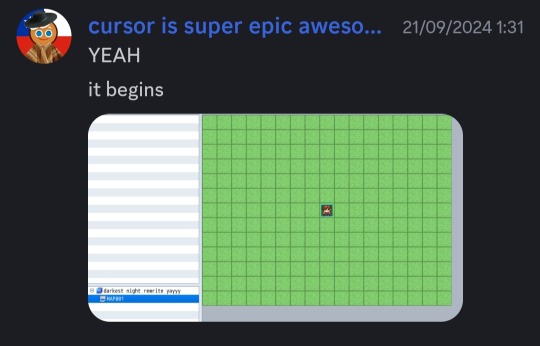
hello!! name's cursor/siffrin and i'm a poor loser making a fangame!! why did i commit to this i could have just made a fic but noooo i gotta pick up rpgmaker again
this devlog is made because. well. all devs do one ithink. also to write down my ocasional progress in this project!! this won't be monthly but whenever i have the time and got something to report yay. spare me from this hellhole
we begin 💥
ever since cookie run the darkest night got cancelled a few months ago and left us with only chapter 1 i did feel sad!! i liked the story!!! gingerbrave cool and fucking awesome moments. BUT!! because i am mentally ill,, i decided to rewrite the game myself and give it the ending it deserved to have!! will the ending be proper i dunno. i am still writing this stuff waugh. but hey it will have an ending at least
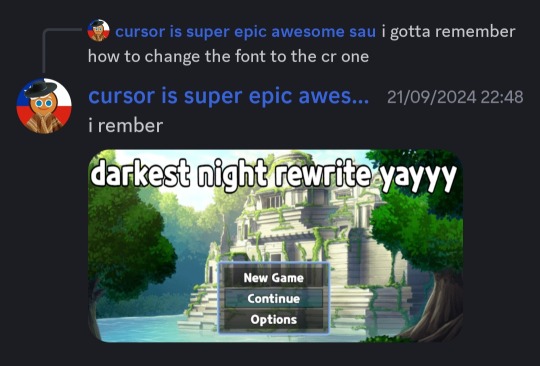
to gamedev stuff proper. i got rpgmaker mz around 2022 for the purpose of making a cr game still. an original one!! however after making a few stuff i left it in hiatus bc i had to focus on school (i still do. college is breathing on my neck dear lord). i still plan to continue that one but it will be after i'm done with this rewrite. in either way. i've been changing placeholder stuff for now,, such as menu icons and figuring out how to make the party have five members. also re learning how to use aseprite because i gotta make all sprites haha (breaks down)


i should remind folks that i am an artist/writer first and foremost. i will very likely go through pure trial and error while making and 'coding' all of this (why did i plan 14 chapters oh my godddd),, though i do have notes i took from the rpgmaker tutorial so i can refer to when i'm stuck whenever and hey!! forums are always a thing!! i wouldn't have figured how to have 5 party members if they weren't!!
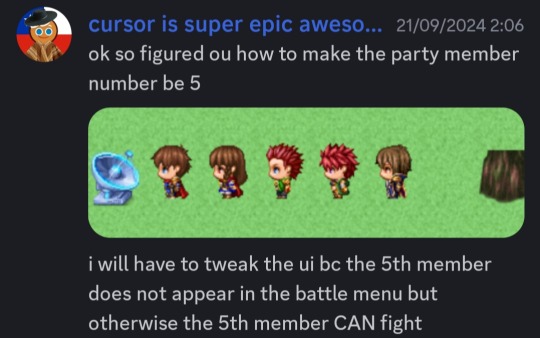
to writing stuff. i've been planning the prologue and the locations of the first 3 chapters so far. as well as a vague idea of chapter 12 and the epilogue. with point A and point B set,, now i just gotta make the middle point. aka the rest of the game</3
the main party and a few relevant npcs and characters have already been set. as well as brainstoming stuff and showing said stuff to the gingerbrave council (personal friend server) for approval of sillyness. you guys are fucking awesome btw if you're reading this. also hi chat

mentally i've been setting a timeline of events. i plan to write these in a notebook so i can have them at anytime and not have to open my laptop whenever i get a cool idea. or dig through thousands of discord messages just to find an idea i wrote down in the moment. overall i believe writing (in comparison to art making and the game making process) will be the easier part for me. also i gotta decide for a proper name for the rewrite. naming it the same as the og is lame. i need something with more sauce. i'll figure it out. in the meantime. have this goober

i'm sure this should be it for this devlog!! hooray!! what have i gotten myself into!!!
in all seriousness i'm honestly pretty excited,, i really want to make this game work and for people to play it!! even if it might be a bit of a pain i really wanna finish this project so there's tgat
that's all. see you all in the next devlog whenever that might be 💥
#cursor speaks#darkest night rewrite#cookie run#cookie run the darkest night#gamedev#devlog#fangame#rpgmaker
20 notes
·
View notes
Text
PER THE "NIGHT SKY" POST--
Hi there. My name is Seta LeCarpetron Flow, known shitposter for the hit 2020 video game Cyberpunk 2077 and generally-unwilling Tumblr funnyguy. If you've stumbled upon this post, congratulations! That means you've seen my shitpost about advertising in the night sky and decided to check out my blog, which eventually led you here. Here's a list of commonly asked questions I see about my shitpost that I thought I'd compile here for your enjoyment.
"Why did you do this?" -- this was a shitpost that escaped containment very quickly and with absolutely no warning.
"Never played the game, can you explain the joke to me?"-- In Night City, the game's setting, holographic advertisements are placed on the top of skyscrapers and scroll upwards for the citizens to look at. The response down below from "@/johnnysilverhandofficial" is a reference to the fact that in the game's canon, main character Johnny Silverhand commits an act of terrorism by blowing up the largest skyscraper in the city. It's a whole thing. The account tweeting, "@/NightCityWire", is the name of the YouTube show where devs of the game would give updates on its progress back when it was still being developed. 'Twitter for Holo' on the bottom is a reference to the fact that in the game, the characters use Holos to communication rather than cellphones.
"Why did you think this would be funny?"-- *'I don't know' noise*, I thought this was gonna hit like, 200 notes at most. The Cyberpunk fandom isn't that big.
"Is it based on something?"-- It's based on this exchange on Twitter that happened a couple of years ago, with a few copy edits. I usually credit inspirations and templates in my posts but again, did not think this post was going to blow up as much as it did.
"What even is the purpose of this blog?"-- CYPK2077 shitposting, generally. Occasionally writing, VP, whinging about lore, and complaining that I can't take photos on PC. The works.
"Are you a roleplay blog?"-- I have no fucking idea why people think this is a roleplay blog. This hardly qualifies as a roleplay shitpost. I don't roleplay. Stop telling people that I'm a roleplay blog in the tags, it's really goddamn annoying.
"Alright, so what's you're biggest issue, then?"-- My biggest issue is that people keep taking this post at face value without understanding the context. That's fine, I get it, the changes I made are not very noticeable and I probably edited it a bit too much, but I need to ensure people that this is a JOKE. It is not REAL. I cannot stress enough that this is a shitpost that got wildly out of hand and it's a little depressing that the state of the world is so whack that people look at this, go "yeah, that's real" and reblog it.
"Why are you making THIS post?"-- Because I've had to read thousands of tags on this post day in and day out lamenting the fall of society and our world's headlong rush towards capitalistic annihilation, and frankly, it kinda wears on me after a while. If I can get at least some person to look at this post and be like "Oh, okay, I get it now" before they reblog it at face value, then I'll consider this worth it in my eyes.
"You know this is kind of passive-aggressive, right?"-- yes, yes it is. But when you've had 27,000 people reblog the stupid shitpost you made in 20 minutes because you were bored at work and seen 95% of them take it out of context and/or make dumb assumptions about you based on it, you'd probably be a little Pass-Agro too.
Thank you for reading my FAQ on this blog's most popular shitpost. Never thought the day would come where I'd need to make this, but here we are.
7 notes
·
View notes
Text
Simon Makes Some Bad Decisions - Character Post
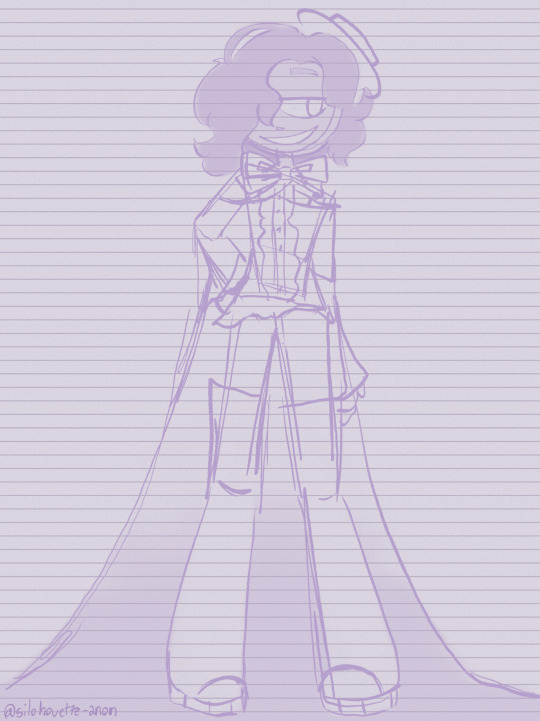
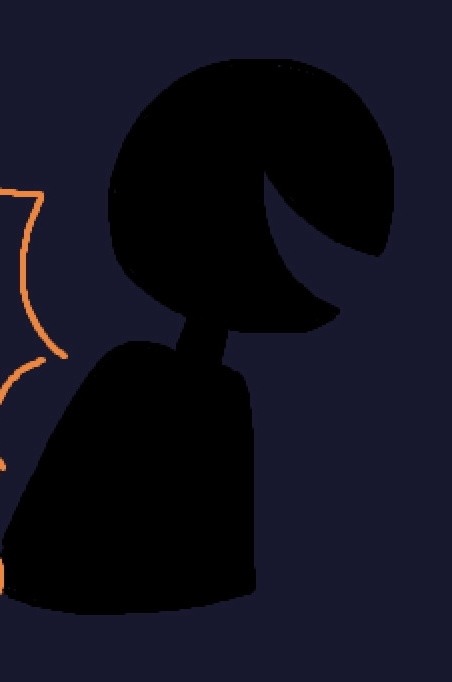
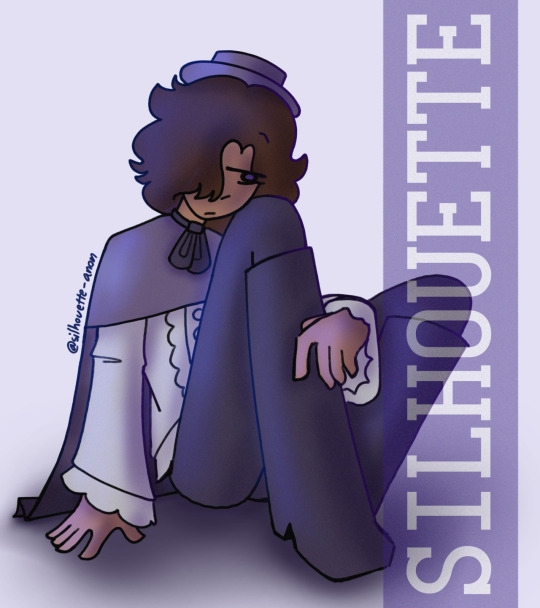

Precircus Name: Simon Mallory Circus Name: Silhouette Secondary Alias: Aleksander (Given and always used by Yelena) Gender: Male (he/him) Species: Shadow Man, Human Origin Titles: Silhouette Anon Powers: Teleportation via shadows, minor shapeshifting, telepathy maybe, otherwise unspecified Skills and other notes: Excellent manipulator, very fancy, uses a gun as his preferred weapon. Good at poetry, likes to read. Redeemed villain, and has more than paid for his crimes, seeing as the circus…is how it is. Can perfectly mimic voices. Partner: Yelena Best friends: Mix and Carbine Sisters: Alice Mallory, Alpenglow (adoptive) Enemies: Sun, Zachariah Woods, Kopi “It’s complicated”: Zombie Murder victim: Zachariah Woods Ex: Mix Mod: Mod Soup (@silhouette-anon) Art credits: Soup


Precircus Name: Isaac Brennan Circus Name: Mix Gender: Transmasc (he/him) Species: Butterfly Humanoid, Human Origin Titles: Bartender Powers: Supernaturally pain tolerance. Skills and other notes: Incredibly anxious. Terrified of guns. Excellent at mixology. His skin is made of something like glass. Gets distracted by flowers. The butterfly thing is a side effect from a reversed abstraction. Partner: Carbine Best friends: Silhouette, Yelena Friends: Dusk, Sun Adoptive Daughter/Sister (it’s unclear): Elida Doyle Enemies: Kopi Exes: Drunk Anon, Silhouette Mod: @sh4tt3rg1rl (Xeya/Basil/Xeyshattersiltav1a) Art credits: Basil, Elsewhere (respectively) Design note: His current design is currently being worked on, so instead you get OG mix and my whiteboard doodle. This will be changed.




Name: Yelena Gender: Female (she/her) Species: Loch Dragoness/pseudo-mermaid, Human Origin Titles: Spellcaster, Healer, “Mermaid”. Powers: Water manipulation, limited shapeshifting (including wings), spellcasting (healing magic specifically), able to summon a trident-staff, water-breathing, otherwise unspecified. Skills and other notes: She’s something of a singer, and was a professional mermaid while human. Ukrainian. Enjoys books and poetry. Partner: Silhouette (she calls him Aleksander) Best friends: Carbine, Mix Mentor: Lady Guinevere Enemies: Kopi Exes: Charles (presumed deceased), three other unnamed guys. Only her relationship with Charlie was healthy and ended on good terms. Mod: @the-moth-from-elsewhere Art credits: All of these are Picrews. She does not currently have a reference image.


Name: Carbine Real name: Nikolai Gender: Male (he/him) Species: GUN- /j. I think he’s some kind of code being. Unknown origin. Titles: None Powers: Dev Console Shenanigans (“The Terminal”) Skills and other notes: Russian. Owns silhouette’s soul. Unclear Origin. Partner: Mix Best friends: Yelena, Silhouette Brother: Artemis/Kepler Enemies: Kopi, Kepler Mod: @master-dealmaker Art credits: Soup and blepxiee, respectively


Precircus Name: Zachariah Woods Circus name: Zombie Gender: Male (he/him) Species: Zombie. The floor here is made of floor. Human origin. Titles: Deputy, Zombie Anon Powers: Gun. Skills and other notes: Excellent at shooting, doesn’t remember himself before the circus. Does NOT know why people are so terrified of him all the time. So sick and tired of the circus chaos. Partner: Skeleton anon Murderer: Silhouette Mod: Soup Art credits: Soup


Name: Alice Mallory Gender: Female (she/her) Species: Human, not digital Titles: none Powers: None Skills and other notes: Aspiring writer and artist. Went missing years ago. There is a theory that she and Northa are the same person, but nobody truly knows. Assumed dead. Brother: Silhouette Best friend: ElidaMod: Soup Art Credits: Soup

Name: Elida Doyle Gender: Female (she/her) Species: Human child, not digital. Titles: Deceased Powers: None Skills and other notes: Talented ballerina. Died when she and Mix got in a car crash. Adoptive Family: Mix Mother: Lilith Doyle Best friend: Alice Mod: @/sh4tterg1rl Art credits: @/sh4tterg1rl
#Simon makes some bad decisions#the moth speaks#The lore saga#The lore saga - characters#This was…way longer than I thought it’d be#edit: WHY DID I FORMAT THIS SO BADLY WHAT#the butterfly#the wanderer#undead deputy#seas and sonnets#carbine#bugboy mix
5 notes
·
View notes
Text
Hello naughty children it's Gehenna time.
...which means I'm going to read the book properly this time and write notes on each scenario, partially for my own reference, partially in answer to an ask from @rayshell22livejournalcom�� from about a zillion years ago. Sorry about that!
Mood soundtrack: Godspeed You! Black Emperor - F# A# ∞; Lift Your Skinny Fists Like Antennas To Heaven; Yanqui U.X.O.
Prelude: Netchurch is an interesting character. Very skeptical, despite, well, the entire setting, although that's definitely, uh, broken by the end. Feel very sad for Afifa, who was a pawn in all this. Creepy babies galore!
Introduction: "While Vampire favors that futile, tragic, and - we'll say it - angst-heavy conclusion" - lmao you don't say. Although I do like how they have the consistent golden rule that if you don't like it, just ditch it! (Of course, the Gehenna scenarios as a whole have been completely retconned anyway by v20 and v5, so this entire book is a good example of taking what you want from it and ignoring the rest.)
"Some people are on opposite sides of this thing. They're elders who don't want to knuckle under to the Antediluvians (most elders will accept their proper place in the heirarchy again with the rising of their progenitors) and poor, misled souls who bought into the lie and are pissed about it (paging Mr. Pieterzoon). Bottom line: the Camarilla collapses like Enron/WorldCom as the worthlessness of its foundation becomes public knowledge. Chaos ensues among the vampire community, princes find themselves besieged by their own locals, and it's all a big clusterfuck."
Have I ever mentioned I love how VtM phrases stuff? Also F to Jan.
I like how they have a masterlist of what's actually going on with the Antediluvians. Spoilers ;D "For example, note that [Tzimisce] is simply referred to as [Tzimisce]. Even here at the game studio, our limited mortal minds weren't able to comphrenend the creature's real name." Lovecraft only WISHES he had eldritch abominations this spooky! Ennoia is 'Active and scary' and apparently spooks the devs just thinking about it. Makes sense. "Giovanni (Augustus Giovanni): Augustus is a pig, and he should probably die as one of the early events of Gehenna. He's the youngest of the Antediluvians and probably possessed the greatest ego (in mortal terms), so it'll be cosmic justice when he eats it." I love how no one likes Giovanni, even his creators. Malkav may or may not BE the Madness Network, in which case they cease to be an Antediluvian and just become... a part of the Malkavians, I guess? Absimiliard may or may not be chilling at the bottom of the ocean, because mood. Tremere / Saulot is definitely a fun one to play with, yeah. Although, oof, if Saulot ever gets control of their shared body, he's going to be fucked up if [Tzimisce] activates, so. Probably better to create a nice fresh body, like what BJD suggests with the child Saulot.
Chapter 1 - the lead-up: Basically a rundown of the signs and how they're interpreted. "An angel dies: How does an angel die? Who has the gall to rise up and slay one of God's firstborn? Or perhaps this is another metaphor. An angel could be a pure and gentle creature, or then again, it need not be one of God's angels (not that God's angels are necessarily pure and gentle). A feared and particularly vicious Necronomist Tzimisce, Sascha Vykos is sometimes referred to as the Angel of Caine. Many would rejoice the night that Vykos died." Hey rude :( I vote they kill Michael instead. He wants to be an Archangel? Fine, he can fulfill a prophesy XD
Honestly I really do dig that Ennoia Earthmelded with the entire planet. You can go so many directions with that, good or bad! Ennoia as The Beast Below, or Ennoia as Gaia? (Wow, that'd really fuck with the Garou XD) I love how the general consensus on Haqim is like, no one knows if he exists or not but lbr Ur-Shulgi is bad enough. Kinda dig the idea of the Toreador ante, Ishtar/Arikel, being genderfluid? I mean yeah essentially demigods have no need for gender anyway, but the constant debates over whether the Toreador ante is the female Ishtar or the male Arikel (or, uh, was it vice versa?) does lead to some interesting concepts. Ooh, similar to [Tzimisce] being linked to its entire clan (and the Tremere, anyone who's ever taken part in the Vaulderie, and anyone who knows Vicissitude), [Lasombra] may be connected to anyone who knows Obtenebration? [Ravnos]... yeah, probably dead. F to the clan. And yeah I think [Tzimisce] is flat-out the scariest one of all, and probably the one most likely to actually start the apocalypse, lbr.
Ugh this is one of the books that calls Sascha 'it' :-\ Do not like. ...Also do not like the suggestion that they're an unknowing agent of the Eldest, given, uh, the last chapter of the DA Tzimisce novel. Shoo! Shoo! You've ruined their unlife enough as it is!
Epistolary material! I do dig those. Most interesting: a letter to Sascha mentioning apocalyptic visions of New York but with the Carpathians in the background, and an anonymous letter to Hardestadt warning him of one of his line tearing down a castle that the writer feels believes the Camarilla. GO JAN FUCK IT UP.
And on to the scenarios themselves!
Chapter 2 - Wormwood: This is an interesting one. Literally a Biblical vengeance - God takes a good look at the Children of Caine and goes, "Well, this is fucked up", acknowledges that Caine never really sought true forgiveness and repentance, and sets forth Wormwood, the Red Star. The truly repentant are saved, the rest just. Die.
Herald here is a dhampir girl named Alia - thinblood father, human mother. When she's twelve, she becomes God's chosen, basically. Traveling with three thinblood guardians, one night, she's approached a Gargoyle named Ferox with True Faith, who sees himself as a fallen angel. And Alia offers him a way of redemption - find the chosen true believers, wait out Wormwood, receive judgement. Anyone can seek sanctuary, only the true believers and the ones genuinely willing to repent will survive the judgement itself. Alia and Ferox set out to find the other chosen ones.
Whew. Very full-on - the players remain in one place with a whole bunch of other vampires for forty nights. I mean, that's a test in and of itself XD All welcome! (Except infernalists and the antediluvians and Caine himself. They're fucked no matter what.)
Like. All welcome XD "Some Storytellers might feel that this character roundup could get too silly, suddenly having all these celebrity Kindred get together for a big slumber party, and they would be correct." Fuck that give me a slumber party AU XD
Am very glad about the note that the vampires inside only lose one blood point per 10 days, rather than every day. Otherwise, uh, it'd get gory.
Yeah, this is a really interesting scenario. Very character-focused, very introspective. All about the characters trying to work out what it means to be good people - not the strongest vampires, not the most powerful, but good people. Are they worthy of salvation? That's the crux of the story. Of course, it's very, uh, Biblical, heh, but it's first and foremost about morality and redemption. I dig it.
Also, giant vampire slumber party.
Chapter 3 - Fair is Foul: Ooh, this is a Lilith vs Caine scenario.
This one has the Withering hit in weird ways, including clan-specific ones - like the Banu Haqim only able to feed on vitae, then only able to gain sustenance from diablerie. Gangrel turn even more animalistic. Lasombra take to the seas, Obtenebration ripping holes straight to the Abyss. Malks, uh, leak madness. Nosferatu get even uglier, Toreador devolve into debauchery. Tremere develop third eyes, and yes, I did laugh out loud when I read that. Tzimisce... hmm... get a bit, uh, uncontrolled. And Ventrue find they can now only feed on... other Ventrue. Fun times!
"At your discretion, Lilith might be particularly vulnerable to Jewish True Faith, as the Jewish tales about her are the source of nearly every negative sentiment ever directed against her in writing. As a result, most orthodox Jews bear Lilith great contempt for defying her husband and her God." Yeah ngl I think she's pretty dang cool and I can just see, like, most of my ancestors facepalming at the idea XD;; Fuck obediance you do your own thing.
"Trying to work out traits for Lilith, Lucifer, Caine, or any of the Antediluvians would just be a waste of our word count and your time." I like the time they published a guide for fighting Caine. It was two words. "You lose."
Ah. Okay, Saulot in Tremere's body being taken over by the Eldest = scary, because have you ever been attacked by an Antediluvian wielding Thaumaturgy, Valeran, and Vicissitude at the SAME :) TIME? :) Yeah :)
Really dig the idea of Abel showing up as the first Wraith. The forgiveness element.
Overall, this isn't my favourite scenario, I think? It feels very chaotic, and while it's probably the most traditional to play, I'm not sure how much it literally challenges the characters, unlike the sheer soul-searching...ness of Wormwood?
Chapter 4 - Nightshade: Chapter starts with, "We all wear masks" and my first thought was "boy you have no idea" XD
Awww yes this is the masquerade break scenario! See here for my thoughts on that and how the Nephtali could be adapted to v5, heh.
Yeah okay earthquakes, volcanoes, and riots are normal enough. A horrible blood virus where it appears some flesh-like thing is living in people's veins and feeding off their blood sounds like something that starts with T and rhymes with Shzimitze. ...Probably. No one knows how the fuck it's pronounced anyway. Oops, those riots are apparently over the existence of vampires. Yeah that'd be... unfortunate. And more earthquakes, this time due to Kupala vs the Eldest. Whew. Red star, yep, standard. MORE earthquakes, this time due to the Second City rising. Sounds legit. Bad times all around!
The details on breaking the Masquerade are interesting. Basic emotions: denial, rationalisation, fear, anger, acceptance. The acceptance one is interesting, because I can definitely see some jumping to it straight away.
So, on to the scenario itself! Jan recruits the players to fight the... uh, mass under NYC. This is the corpse of the Eldest, which is more or less a giant fungal infection held together with Vicissitude, which frankly is just icky. This actually is canon-compliant with BJD, since it apparently has only just... dissipated? or whatever there, or if it still remains, it's no longer conscious. In this one, its soul flicks back to Tremere's/Saulot's body and wakes up, and basically every Tzimisce, Tremere, and anyone who has ever drank Tzimisce blood (which would be the entire Sabbat via Vaulderie) spontaneously frenzies. Godspeed. Cyscek, a Tzimisce methuselah, helps defeat the, uh, blob at the expense of his life, and warns with his last words, "The Dragon rises. You must stop it. Find Vykos. [They] know." (Okay yeah the text says 'it knows' but also fuck that.) Ooh, plot point!
Aaaand then they retreat from the battle, exhausted, only to find the whole damn thing broadcast on every TV screen, vampiric Disciplines and Cyscek dusting and all. W h o o p s.
Lots and lots of details of a major masquerade breach here. Hardestadt shows up and tells Jan he's proooobably gonna get Final Death for, you know, trying to save the world. Gonna share this bit because it's Very Satisfying.

Please refer to my tag #hardestadt has no rights ;D
Anyway! The characters now recruited, Jan leads them back to London for the Convention of Fire. He's working with Calebros and... like a bunch of others, probably anyone can end up here, so long as they want to actually help and not just fall apart like the remnants of the Camarilla (trying to diablerise their way into keeping power) and the Sabbat (...ditto tbh). Those definitely in attendance are Ambrogino Giovanni, Hesha Ruhadze, and Fatima! And lbr the Nod Squad are probably there too. As if Beckett would pass up the chance to NOT witness what's happening with Gehenna. And Anatole is literally a prophet of Gehenna! They found the Nephtali, led by a council of twelve, with Jan at the head. Name means 'the highest point' or 'no further' - as in, Gehenna goes no further than this.
Oh lmao here we go, the scene I mentioned earlier - Jan vs talk shows.
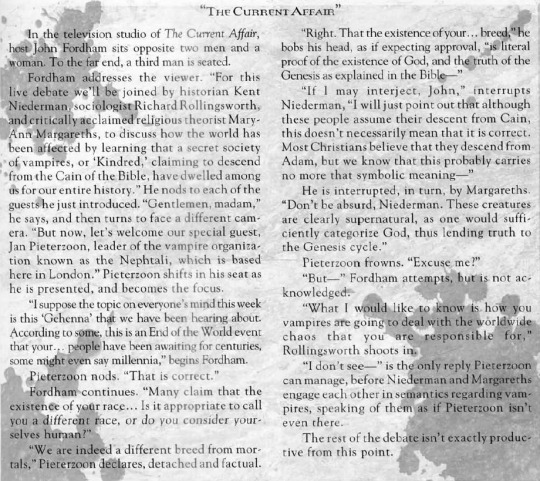
F to Jan.
Tremere's body (inhabited by Saulot) disappears from beneath the Vienna chantry. Tremere's body, with [Tzimisce] now well in control (having overtaken Saulot; Tremere, meanwhile, has taken over Goratrix's body, with Goratrix's mind stuck in a mirror... it's complicated), wipes out the Vienna chantry. RIP to the Vienna chantry, which doesn't survive in either timeline tbh. Hey, I wonder if that means that Saulot (in Tremere's body) is dead in v5? Etrius manages to escape and reports that the Eldest is now on the way to Ceoris, where it'll call all the remaining Tzimisce to it to become, uh, a part. Pleasant.
Everything between Krakow and Bucharest is straight fukk’d. Ceoris is the centre of all this - IIRC it's somewhere in the southern Carpathians, nearish Brasov. Either way, hell of a fight results with what can only be described as an eldritch abomination, finally both managing to destroy Kupala (the Eldest's goal) and reducing The Thing down to a human-looking body. This bit is interesting! Tremere (in Goratrix' body) and Etrius take one look at each other. "Master..." "I... I know. But where the hell is Saulot?!" Good question, because he sure ain't in Tremere's, uh, former body any more, which was in fact what was fighting them the whole time. Either way, Tremere-in-Goratrix'-body leaps at [Tzimisce]-in-Tremere's-body and diablerises his, um, former body, which must be weird as hell, then tries to turn on the characters and his powers fuckiNG FAIL. EAT SHIT TREMERE. And then the players kill him too and realise that over the course of one night they've destroyed the demon Kupala and two Antediluvians, Tremere and the Eldest. Not bad. This is the battle that causes that second lot of earthquakes I mentioned earlier.
Back to London! They find the mirror containing Goratrix amongst Tremere's belongings. Poor fucker sorry not sorry.
And now the players receive a summons to escort someone from Montreal to the Nephtali headquarters in London! Namely, a Tzimisce named Myca Vykos~ They've recently defected from the Sabbat and want to help take the Antediluvians tf down. (Note: the book here has reverted to using he/him pronouns since they're back in their original form, I'm going to keep using they/them because biological sex does not determine gender identity or pronouns goddammit. ...Anyway. I AM going to use the name Myca since that's the name they're using themself, mostly because, uh, 'Myca' is a bit less noticeable than 'Sascha Vykos', haha.)
So Gehenna has started. Myca's woken up in their original form and being like, "Hey you know what I am preTTY SURE I don't want to serve the Eldest" and promptly joins the Nephtali.
From New York to London to Romania to London to Montreal to London (...London is a hub world apparently), now off to Turkey, to Kaymakli! Which is actually a real place, my brother's been on a tour there. Anyway, this is the part of Kaymakli that they don't show the tourist and that's been sealed shut with lots of angry Cappadocians instead, so that was fun. Presumably Kapaneus hasn't been chilling out there in this one.
Also Colombia has completely been overtaken by the Sabbat so that sucks.
Into Kaymakli! Which usually doesn't let Cainites back out so it may be one-way. Don't worry, there's a ritual for that. At the bottom, they find Augustus Giovanni! Who is pissed off he never actually got to eat Cappadocius' soul and so wants to eat God instead.
As you do.
The book very strongly encourages the players to kill him. Just 'cause. Which is a mood, tbh. Killing him also reveals a beaten, bound Nosferatu, having been Giovanni's most recent food source. An F for Okulos. He's been there for four years, having managed to get a lost fragment of the Book of Nod for Beckett, who promised to come back for him and. Didn't. Which is just rude tbh and I can kind of understand why Okulos ends up betraying Beckett in the Gehenna novel but anyway. (Not canon as of v20, he's perfectly present and chill in BJD.)
End results - the fragment that Okulos went to retrieve shows how to restore the Second City, which holds a complete Book of Nod and may hold the key to stopping Gehenna. It's in Enochian so your player characters probably won't be able to read it (book suggests asking Sascha or Ambrogino). Next stop, Egypt, and a meeting with Hesha Ruhadze! Man this scenario has a lot of signature characters. It also suggests getting third parties in here too, so Beckett would actually be a really good choice. Either way, they find the probable site, and suddenly, a Second City.
Archeologists make grabby hands. Beckett, somewhere, is probably crying in joy. They find a vial with some very old blood in it that they definitely shouldn't drink because otherwise they'll explode (the book uses Sascha as the example here XD;; ). Along with some mystical enscriptions, they return to London and get to work on the prophecy - namely, it suggests that 'the gentle one' (likely Saulot) will die at the hands of another, but arise in a new form, and will stop Gehenna that way. Etrius, one of the only Tremere left and having joined the Nephtali, goes 'fuck it what do I have to lose?' and goes to find whatever new form Saulot is in (potentially can also involve Goratrix here).
Hm. Well. Saulot is apparently in a research centre outside Sydney. Apparently we're mostly chill with vampires, aside from Christians XD Go figure!
Apparently it's a cloning facility. One of the rooms had, past tense, a child, successfully cloned six-year-old, who was in perfect physical form but vegetative from birth. Religious characters will pick up that it's because the kid's body didn't have a soul. Now, it does - Saulot's. Having been thrown out of Tremere's body when the Eldest took over, his soul fled until it could find the most suitable vessel - a soulless cloned body. No actual soul to have to subdue. Saulot ends up reborn, albeit in the form of a six-year-old and without any memories. Turns out, the child was taken by a cult of Thinbloods, believing him to be the messiah.
Sydney's messy situation gets described here! Short version, Sydney's Prince is/was Sarrasine, who was a Toreador. Except he wasn't a Toreador, it was a fairly open secret he was only POSING as a Toreador - he was actually a Caitiff. (Except he's not actually a Caitiff. He's a sixth-gen Setite. Sydney is Like That, yes.) Given Sydney's independence from the sects and its apparent Caitiff Prince, it's become a major site of Caitiff and Thinbloods, which Sarrasine is just thrilled about but can't do anything about because he doesn't want to actually go 'lol I'm a Setite'. Anyway, either way, everyone is unaware of Saulot's return, so the players seek out the little boy, who's pretty spooked and confused. Asks the characters, "Who are you? What is this place? What do all these people want?" and his third eye opens. Tada! Salubri Antediluvian, and like the prophecy mentioned, he's 'unholy' and 'a mockery in the face of God' - a clone.
Back to London with kid!Saulot. The Nephtali have been trying to work out what tf is going on. A researcher tried drinking from the vial. It was messy. The characters might get some downtime. Sarrasine's followers may attack to try and get the kiddo back. Either way, everyone goes to bed, and wakes up to find a Darkness having overtaken the sun, which is generally not good for anyone, and Lasombra characters are just, feels bad man. The Veil of Darkness means vampires can be up 24/7, along with other things that don't like sunlight, and I imagine things like... plants not being thrilled. Also probably very confused animals. I'm not sure if it's like a dark atmosphere, or a physical body between the sun and Earth that just eclipses it whatever vantage point you look from, or what? Disciplines like Auspex, Obfuscate, and Obtenebration go a bit fucky. Then, a few days later, everyone feels a... Summons. For low-generation vampires with still-living Antediluvians, it's strongest. Higher gens with destroyed Antes, not so bad. So I'm sure you can guess what's summoning them.
Yep. Antediluvians. Banu Haqim are getting summoned to Alamut instead so Ur-Shulgi can turn them into an army against the Antediluvians, so godspeed resisting that, Elijah.
Off to the city of Gehenna (it's nearish Jerusalem). Elders of all stripes have been heading there to kill their childer in hope of being rewarded by their Antediluvians to get their powers restored, which is terribly rude. Indeed, the Antediluvians basically go, hey, can you not, and also can you start Embracing more childer for our armies, because they're not very nice either. Pretty much all the characters have been summoned for their crimes against the Antediluvians, and now they're gathered before them - Set, [Lasombra], Ennoia, Absimiliard, Malkav (as like... a cluster of identical little girls with glowing eyes because of course Malkav would use the Creepy Child trope), and [Toreador], who's so beautiful no one can tell if they're male or female. When the players and child!Saulot get there, they question him, but he's literally a six-year-old boy and is spooked. He also has the vial, somehow. Set takes it, and Kiddo says, "Don't drink it. You'll burn up." So Set makes Kiddo drink it instead, because he's a nice guy like that.
Kiddo's third eye opens. A giant black throne appears. The dozen small girls that are Malkav say, "Father's home." Kiddo!Saulot says, "No, Father's dead." Girls start screaming so loud people start bleeding thick black blood from their ears and doesn't stop until Set kills all twelve. A random stranger, now with their glowing eyes, steps forward and basically goes 'wow rude'.
Powerful beam of light appears. The Antes (aside from Kiddo!Saulot) writhe in pain. Angel appears, asks Saulot if he's willing to atone for all vampires. He agrees. Throne explodes, Antes fuckin' die, and everyone promptly frenzies and tries to eat each other, because vampires. In the aftermath of that, vampirism basically... ends. The player characters may be rewarded by becoming human again, as do a lot of Thinbloods, but most everyone older just, uh, dies. Vampirism ends, but the Earth has been saved.
That is... hmm, bittersweet, I think. It's a pretty compelling chronicle, very dramatic, but it's much less character-based and is more, 'the characters get dragged along to Do Shit'. I kind of like the idea of it being a story involving the characters we know, but for original characters, I think Wormwood is a much more compelling scenario so far.
Chapter 5 - The Crucible of God: Okay I'm tired now and this is the 'rocks fall everyone dies' scenario so gonna skim-read this one.
This is the chapter that introduces the level 10 power for all disciplines - Plot Device. The Antediluvians can do shit because they feel like it. Whew. Also, if an Ante spots anyone of their blood line, they can just make them... explode and their blood gushes into their mouth. Monch monch. Spot another clan mate? Roll to avoid frenzy. Just woke up? Roll to avoid frenzy. Good times!
And then the Tzimisce Antediluvian awoke as a mass of Vicissitude flesh fungal infestation with tentacles and lampray mouths and stuff and ate anything in reach until it ate, uh, every living thing in Manhattan. In one night. Bad day tbh. Eventually it burns when the sun rises, but what's left underground is still there and shit's still messed up. Like picking a leaf off a dandelion and it starts bleeding. Trees with faces, swarms of insects forming into eyes and watching. Nice and creepy. In the aftermath, it's basically infecting every life form on Earth with Vicissitude, which is distinctly uncool.
Absimliard has an animal army and currently looks like a giant humanoid jellyfish.
Oh boy here's the Banu Haqim part XD;; Interestingly, it's a lot better for them! Haqim doesn't eat his childer, they feel themselves strongly bonded to him but still maintain their own minds and wills. Downside, anyone who doesn't follow Haqim alone gets hunted down so he can eat them, so Ur-Shulgi's probably having a field day at being vindicated and poor Pyre/Elijah is hiding tf under the bed. Plus side, it only lasts a few months before something kills Haqim, so hey! And there's genuinely a way to become human again, especially for high-humanity, high-gen vampires, so that actually would be a genuinely good outcome for Pyre/Elijah.
Malkavians end up as a giant hive mind. Like, more than usual. [Lasombra] covers the world in darkness, then it stops. Ennoia merges with the entire planet and starts eating people. And vampires. And Methuselah. And other Antediluvians. She's kinda hangry at this point.
Tremere attempts to rule the entire world using the Human Genome Project as the true name of the entirety of humanity. It lasts about two minutes before [Tzimisce] turns him into a meat crime, along with, uh, the entire rest of the world, aside from the players, who were part of Tremere's ritual and thus immune from it.
Also Saulot, who they just met in the form of a little old man.
Turns out, he planned it all along. Lured Tremere to him, knowing that his body was tainted by using Tzimisce blood to become a vampire. Knew that when the Eldest returned, he'd be succeptable, and Saulot would be able to bounce out when the Eldest took over. Now, he can lead the characters in the only way to stop Planet Tzimisce, which is, uh, prayer and letting themselves get eaten. Could actually work! And you end up human again in the bargain!
End result - all vampires gone. Some of the more human ones do end up human again. Either way, world's still fucked. Open Antediluvian rule for several months has destroyed most of humanity. There are still remnants - former Malkavians who are still a bit weird, former Tzimisce who are a bit... Vicissitudey. Ennoia's still around! She's mostly chill except when she occasionally feels like rearranging landscapes. Otherwise, it's time to recover.
Alternate endings - that last one wasn't depressing enough, so here's a scenario where All Is Tzimisce, here's one where there's global extinction of literally everything except the player characters who gradually drop into torpor and never recover (or just flat out burn if they're outside), or there's one where the players are the only vampires left and start a new cycle with them as the new Antediluvians or something, oh and Caine's still kicking and is Very Displeased that God won't let him die already. Gooood times!
Rest is how to basically play it, and character sheets. Which go back to calling Sascha ‘it’ again *sigh* (And using the whole alien look despite explicitly mentioning that they look human again. Of course.)
So, final thoughts! Gehenna is... an interesting scenario. Lots of possibility for introspection. It’s very... apocalyptic, and that may bother a lot of people, since, well, for the most part, it’s going to be the end of playing your character as a vampire. Which I figure most people are playing Vampire the Masquerade for. So it’s basically either a hell of a finale, or you just don’t make use of it.
Favourite scenario did end up being Wormwood. I just really like the introspection and opportunity for hope. Did also enjoy Nightshade, but in a different way, I think? Like for Nightshade, I’d rather read it as existing characters working together, maybe as a novel, whereas for Wormwood I’d want to play it since it’s such an intensely personal kind of thing.
(I also still want a slumber party AU ngl.)
32 notes
·
View notes
Text
From Bridgerton to Hamilton: A History of Color-Conscious Casting in Period Drama
https://ift.tt/2IQI6Ak
Note: This Bridgerton article contains no book or series plot spoilers.
Bridgerton is a unique mix of Shonda Rhimes’ dedication to Black representation on American television and the British period drama tradition. White critics may dismiss this trend as unnecessary “pandering” to Black and POC viewers, but the number of productions designed around reforming all white-casting has increased over the past 10 years—and has only added to the success of the genre. The number one reason driving demand for diverse period dramas is from Black and POC fans of the genre. The impact of seeing an actor that looks like you can’t be measured in ratings or clicks online. Despite facing years of content and fandom overtly or covertly claiming that the universal themes in period dramas are not “for us”; the tide is starting to turn as fans use social media and the power of ratings to ask for more representation.
A quick overview of recent Regency England-set productions leaves much to be desired. Although the 2018 Amazon Prime/ITV miniseries and the 2005 movie adaptations of Vanity Fair left in West Indian and Jewish heiress Miss Schwarz, she is one of many supporting characters. PBS/ITV’s Sanditon, on the one hand, improved representation by prominently featuring Georgiana Lambe. However, her story was a huge disappointment to Black and POC fans who expected her plotline to end happily or at least have her conflicts resolved.
There have been three paths traditionally towards increasing diversity in period dramas: 1) blind casting (also called racebending), where Black and POC actors play traditionally white characters adding original Black characters to existing fictional works, and 2) Own Voices, where Black and POC writers share their own stories. These two are not mutually exclusive, but, in the world of British period drama, the former is more frequently used, as the bedrock of the genre is adapting existing novels and plays by white authors.
The theoretical framework for inclusive casting begins in the world of staging period drama at the theater. In Shakespeare’s day, men played women’s roles as women were not allowed to appear on stage. The genre evolved in later centuries to allow women to appear on stage, but the tradition of having actors who didn’t match the original descriptions remained. This is even true of his history plays where real women royalty were characters. Ira Aldridge in the 1840s was the first Black actor in Britain to play traditionally white roles on stage. Later on, in the 19th century, several stage adaptations of Jane Austen’s works had all-women casts.
Fast forward to 2015, when Lin-Manuel Miranda in Hamilton redefined what it meant to cast inclusively in modern period dramas by using actors descended from slavery and colonialism to play the Founding Fathers. Every aspect of the musical was designed to reframe the existing narrative of early American history. The costume design also reflected the identities of the actor by featuring braids, locs, and textured hairstyles over 18th century white hairstyles. Rap lyrics conveyed to the audience the names, dates, and other descriptions of the Revolutionary War. The old adage that someone must “look the part” to play a biographical role was thrown out the window.
Hamilton proved that many of the old excuses used to sideline diverse period dramas no longer held to be true. Millions of white people listened to the cast album, brought tickets, or streamed the movie on Disney+. UK theater patrons flocked to the West End cast of Hamilton, as well, before the pandemic. Memes, parodies, and more on social media proved that white audiences can conceptualize historical figures as fictional characters while also knowing the real figures looked and acted quite differently. Fans of the show pushed Ron Chernow’s biography back onto the bestseller lists as they wanted to read what really happened.
The first clear impact the show had on the genre of British period drama comes from a mystery. Daisy Coulam, Grantchester’s head screenwriter, cited reading an interview with Miranda as the inspiration behind the exit plotline for James Norton’s character Sidney Chambers. UK crime dramas For those unfamiliar with the series, Grantchester is a mystery procedural based on a series of books about a 1950s crime-solving Anglican vicar by James Runcie. Norton’s exit plotline in Season 4 generated an original to the show character named Violet who was the daughter of a visiting African-American preacher. Violet was an original character who forced the audience to consider that the US civil rights movement indeed reached their treasured vision of the lily-white British countryside. Coulam already laid the groundwork for Violet in earlier seasons by abandoning large sections of the original novel timeline and but keeping the case of the week focused on addressing 1950’s social issues. Fans heavily criticized Coulam’s writing for style and pacing, but her imagination clearly indicates that Hamilton’s proven formula for disrupting established historical aesthetics can just as easily be applied to fictional depictions of the UK’s past as blind casting a biography-based series or depicting real figures of Black British history.
Other period dramas released in recent years share traces of Hamilton’s impact but in a more thematic and less direct different way. Some shows turned real Black British figures into fictional characters. Lina (Stephanie Levi-John) and Oviedo (Aaron Cobham) on The Spanish Princess are composites of Catherine of Aragon’s servants and several famous Black Tudors. Catherine “Kitty” Despard (Kerri McClean) in Poldark Season 5 was a forgotten Black British figure added in to expand the world outlined in the novels. Victoria featured Ira Aldridge (Ashley Zhangazha) mentioned earlier, plus spotlighted the Queen’s adopted daughter Sarah-Forbes Bonetta and Cuffay (C.J. Beckford) as the leader of the proto-socialist Chartists. Lucille Anderson (Leonie Elliott) on Call the Midwife was not mentioned in the original memoirs, but she was added to represent the Caribbean nurses from the Windrush Generation of UK immigrants.
Racebent casting also increased. Dev Patel’s role as the title character in the movie The Personal History of David Copperfield proved that Dickens adaptations could indeed include POC casts without changing the fundamental plot and message. PBS/BBC’s Les Miserables miniseries also extended the Broadway tradition of casting Black actors in traditionally white coded classic literature characters. Hulu’s The Great featured Sacha Dhawan and several Black actors as Russian nobility, politicians, and courtiers.
All of these series, however, carefully attempted to stay grounded in recreating the original source material or invested in faithfully replicating the era they were set in. Bridgerton radically expands upon Hamilton’s formula by divorcing inclusive casting from any desire to accurately recreate historical events, eras, or figures. Romance, fantasy, and social/familial drama are universal themes that don’t depend on having a white-dominant vision of society. Quinn’s original novel series sparingly referred to historical events during the Regency Era. Her focus was on creating a world where the most important events were balls and weddings. More Dukes and other holders of inherited titles exist in her vision of the Ton (the most elite members of Regency society) than in reality. Historians would likely dispute her characterization of the elite social season as well. Characters’ internal dialogue is in modern English peppered with regional accents and slang. They rarely lampshade or criticize the way of society beyond their romantic desires and family obligations. Readers see the physical intimacy on the page Austen never mentioned. This literary environment is ripe for inclusive casting on screen.
The most critical flip in characterization is Simon, Duke of Hastings (Regé-Jean Page). His character is the romantic hero of the first book in the series The Duke and I and is the character that set fan expectations high for future novels. Simon having visibly African features and yet being an object of desire is incredibly subversive in a genre where white beauty standards dominate hetero and homosexual fiction.
Lady Danbury (Adjoa Andoh), Simon’s godmother, is an elder stateswoman and a twist on the battle-ax aunt trope popular in period dramas. She isn’t as caustic and insulting as some other famous widows and spinsters but she commands authority and a mansion filled with people to perform all the hard labor. Lady Danbury is even implied to be slightly higher in status than her white counterparts with children of marrying age Lady Violet Bridgerton (Ruth Gemmell) and Lady Portia Featherington (Polly Walker).
Queen Charlotte (Golda Rosheuve) being played by a biracial woman is actually a subtle Easter Egg to existing history debates. Many have debated if her portraits were airbrushed to disguise African features. A few years ago, a documentary established her African ancestry is via the Portuguese royals. All of her scenes involve petting her Pomeranian, demanding to know the latest gossip, and manipulating the gentry into doing her bidding.
The miniseries doesn’t end the racial diversity with those at the highest social rank or even at the lower orders of domestic servants. Marina Thompson (Ruby Barker) is a cousin of the Featheringtons and represents the “poor relation” character popular in stories based on the British gentry. A Black modiste (dressmaker) trained in French fashion makes all of the dresses the characters wear. Will Mondrich (Martins Imhangbe) is a boxer, likely a reference to former slave turned bare-knuckle boxer Bill Richmond. Alongside the characters with plot lines viewers follow, there is a conscious effort to hire Black and POC extras to fill in crowd scenes at balls, park scenes, and other public events. The viewer sees people who look like themselves in every class level of society and can feel like they too can become part of their world.
Read more
TV
How Bridgerton Can Avoid Outlander’s Mistakes
By Amanda-Rae Prescott
Books
Bridgerton: Cast Announced for Shonda Rhimes Netflix Series
By Alec Bojalad
Attire is a critical part of upholding the fantasy and cultural diversity Bridgerton and also in communicating to the audience the series isn’t your aunt’s neutral tone Austen adaptation. Marina and Lady Danbury would never be caught dead in a plain white muslin frock. All of the popular Regency hairstyles for women have been modified and reworked for natural textured hair, braids, and locs. Some of the Black male extras even have modern African hairstyles left in tact. The only Black characters who wear the traditional white wigs are older men or servants in full formal uniform. Queen Charlotte’s Black courtiers and servants wear a mixture of extravagant 1770s and 1780s attire and Regency court wear to create a physical separation between them and the rest of the ensemble cast. These style decisions are right out of the playbook of Still Star-Crossed, Shondaland’s first foray into period drama. Although that series took place in 1300’s Italy, the priority was on blending fantasy and Black fashion aesthetics over catering to white costume enthusiasts and reenactors.
In the world of Bridgerton, slavery and colonialism are directly or indirectly referenced exceedingly sparingly. One reference is to Lord Dunmore’s army of emancipated and runaway slaves during the Revolutionary War proclamation. (Hercules Mulligan’s Black troops referenced in “Stay Alive” is the Patriot equivalent of Dunmore’s forces). These sparing hints make it clear to the viewers that class, family, and personal family drama is the root cause of joy and pain in this series.
Since Bridgerton is completely ignoring the physical descriptions of the characters in many cases, the set design carries the bulk of the attention to historical detail. The series hired Dr. Hannah Greig as a historical advisor to ensure these details were as close to 1813 as possible. Greig has previously acted as a consultant to the Sanditon, Poldark, and The Duchess cast and crew is likely where the Easter Eggs in character references come from. Lavish mansions and castles and the more humble spaces ground the fantastical plot details in historical reality. Several previous period dramas have recreated the Vauxhall Pleasure Gardens, but these scenes in the miniseries are elevated to the next level thanks to Netflix’s budget.
Read more
TV
Noughts + Crosses: Why You Should Watch This Afrofuturist Alternate History Romance
By Amanda-Rae Prescott
TV
World on Fire Returns People of Color to the Dunkirk Narrative
By Amanda-Rae Prescott
The success of Bridgerton applying color-conscious casting to a fantasy/romance series has implications far beyond potential future seasons. Studios especially those in the UK have been hesitant to utilize recent historical romance books for screen adaptations. Modern historical fiction by Black and POC authors (called Own Voices fiction) which is crucial in the fight for increased representation. Novelists such as Beverly Jenkins, Courtney Milan, and Alyssa Cole have written romances set in the Regency and other eras of American and British History that can easily be transformed into movies and miniseries. Some of these novels recreate existing history while others lean into escapist fantasy. The ultimate goal in period drama representation is for Black and POC creatives to tell their own stories covering all the ranges of emotion, not just historical trauma.
cnx.cmd.push(function() { cnx({ playerId: "106e33c0-3911-473c-b599-b1426db57530", }).render("0270c398a82f44f49c23c16122516796"); });
Critics can keep attacking period dramas for being “too woke” (a term that was stolen from anti-racism activists) for remembering that white people aren’t the only inhabitants of the British Isles and America, but series like Bridgerton are here to stay. Black and POC viewers and readers of period drama and romance fiction always existed, and viewership will only grow if more inclusive period romance projects are greenlit in the future.
The post From Bridgerton to Hamilton: A History of Color-Conscious Casting in Period Drama appeared first on Den of Geek.
from Den of Geek https://ift.tt/3mjLv8v
10 notes
·
View notes
Note
I really don’t understand Aer/ith character in the OG we she fell for Cloud but my question is how she fell for him if she didn’t know the real him ❓ i mean for 4 years she didn’t move one from Zack but then came a guy who she knew nothing about esp the real him she was interested in him because he reminded her of Zack but she came to love when she barely knew him and didn’t know the real him not to mention that crappy fanfiction Maiden novel stating she loves Cloud more than Zack wtaf⁉️❗️1/2
I mean seeing how things changed in the remake i wonder if the devs are going down that road again with Aer/th falling for the not real Cloud again esp after all that Aerti friendship build up like i know Cloud is the protagonist but they don’t have to make every girl in the game fall for him ,opposite sex can have beautiful friendship without forcing romance into it,even if it fan service do they know it this fan service that many people got their story wrong and twisted it 23 years ago 2/2
Hey there! Thanks for the ask.
So everything I’m going to write is my opinion on the matter and how I perceived the game (OG and Remake, mainly). Many moons ago when all this LTD stuff started, there were comments made by the devs about there being a love triangle. This was meant to enforce the illusion of Cloud’s persona. So, it did exist in OG. It wasn’t the main point of the story, and it was very subtle, especially to western audiences. I’d say OG’s makeup was maybe 5% romance, 95% other crazy shit.
The problem is, people took it to be the ENTIRE game. So here we are, 23 years later...
First, OG Talk
In any case, my view on Aerith, Cloud, and Tifa... I think when people say that Cloud was in love with Aerith or Aerith was in love with Cloud, they’re using too strong of a word. Love is a really strong word for what they may have had. I’d say it was infatuation at best.
Cloud wasn’t even aware that Aerith was interested. This is canon that he was oblivious to both Aerith and Tifa’s feelings.
I do not think that Aerith was “in love” with Cloud at any point. I do think she was very interested in him at first because she saw Zack in him - he had the same sword, wore the same clothes, and in OG, he had some of his mannerisms, like the squatting.
In Remake, Aerith is more interested in finding out about Zack. She even tells Cloud UP FRONT once they sit down to talk about this, that Zack was her first love. In the OG, she says it wasn’t serious (then later admits she loved him). Zack and Aerith were together for quite a while prior to his departure for Nibelheim, she then wrote 89 letters to him.
To say Aerith didn’t care about Zack like MWTtP does always blows my mind and makes me a bit angry. For one, it makes Aerith look like a total asshole towards Zack. This guy could have run out of Nibelheim undetected and left Cloud there to rot, but he made sure to get him out and then made his way back to Midgar. Of course Cloud was slowing him down. He could barely walk, couldn’t talk, couldn’t feed himself, and this guy TOOK CARE OF HIM.
And the whole point was to go back to Aerith. That’s the reason he was going to Midgar. They could have stopped in Gongaga, Cosmo Canyon, take your pick of town, but it was right to Midgar.
Problem is, most of the stuff I just wrote wasn’t known until Crisis Core came out, almost 10 years after OG. So people assumed that Zack was a ladies man, since that was said in the OG, and that he didn’t care about Aerith. MWTtP was written before Crisis Core. MWTtP also is NOT canon.
In the OG, Aerith’s date is more to give the player the foreshadowing that Cloud isn’t who he says he is. Now, most of us that played this game back in the day were kids or teens. A lot of these things went over our heads.
This is long as hell, so here’s a Keep Reading
In my opinion of OG Romance Piece: Cloud was a bit infatuated with Aerith, but didn’t forget about Tifa, they’re just terrible at showing it. We remembered the game WRONG in many cases (that’s a whole other post). It’s important to note, you CAN be flat out mean to Aerith based on player choice in OG, but CANNOT be MEAN to Tifa. You can be neutral with her, but not flat out mean.
I mean, let’s look at the GS dates. Aerith’s date ends and she asks you if you don’t like spending time with her. You can tell her you don’t or you can tell her you do, but Cloud follows up with “It’s not that..”
Tifa’s date ends and Cloud wants to know what she was trying to say, but she clams up and can’t. You do not get a choice on whether Cloud had fun with Tifa or not - he apparently had fun.
I did NOT see anything honestly in OG early on. The romance for me wasn’t there until way later, when it’s slammed in your face in Mideel when Tifa is like “I’m gonna stay by his side.” I remember being like “ohhhhhhhhh....” (Still did not really ship or see much romance in FF7 OG, though, as a kid).
As an adult, it’s easier for me to see it and pick up on things, but I still actively looked for CA stuff and it’s really not as extreme as it’s made out to be.
For me, the Love Triangle died when Aerith died. In the OG, after Aerith dies, she’s not mentioned again for a lonnggg time. It had forgotten about it by time they mention her again. Some people were very attached to her and had a hard time playing past this point, it seems...
My Thoughts on Remake and the Future Parts
Okay, so Remake blew me away. As somebody who came in to it with no shipping preference, I was like “okay I don’t remember this stuff...”
Remake is definitely HEAVY HANDED with sexual tension and romance... but only really with Tifa and Cloud.
Aerith HERSELF ended the LTD. Her resolution, her side comments, how she completely stops flirting with Cloud, SHE ended it. However, I don’t think she would have had to. Cloud didn’t seem to really enjoy Sector 5 all that much. I was pretty surprised when I played it and Elmyra said “Don’t talk to Aerith again.” and he’s like “No problem, see ya.” I was like oh okay.... so... what is going on with this? (I also did ALL of Aerith’s quests including Language of Flowers, so it’s not that I didn’t see all of it.)
Aerith also immediately starts to attach to Tifa, and as time goes on, moves to trusting Tifa more (so it seems). And I’m really happy about that.
I do not think Aerith will even try to pursue anything with Cloud, nor will Cloud try to do anything with Aerith.
The line was drawn in Part 1. Cloud is almost borderline obsessed with Tifa - when Tifa is sad he says her name, when Tifa isn’t in his view, he’s looking for her, he touches her constantly.
If Aerith suddenly was like “fuck Tifa, I’m going to try to get with Cloud” it would really just... screw up all that buildup in Part 1. I think that Zack was shown as well to really just keep adding nails in the coffin for this. It also would be BOTH Cloud and Aerith completely pulling 180s on how they’ve been acting.
I’d be absolutely shocked if they do that. If anything, I think you’ll see Tifa and Aerith’s relationship get a lot stronger.
I would say that they showed great improvement with his relationships with Barret, Biggs, Wedge, and Jessie. They showed him getting more comfortable with Tifa (even though that went quick compared to the others). The one relationship I didn’t see much focus on improvement or him being more open with long term was Aerith.
We rescue Aerith in Chapter 16 and he’s like “cool, let’s go.” He barely says anything to her. It’s the one person that is just “around”. Their interactions past Chapter 12 are almost just a way to drive the plot. The exception is her resolution if you get it, but her resolution also is packed full of OG references and foreshadowing. Everything Aerith says and does is important for the overall plot.
In Chapter 17 and 18 he only talks to Aerith directly regarding what’s next and what’s going on.
Hopefully that answered your question. I like talking about this stuff!
20 notes
·
View notes
Note
hey! i noticed that you’ve written a lot about how voltron fails as a mecha series, and it got me curious about what a GOOD mecha series looks like. do you have any recs for someone whose only experience with the genre, quite literally, is voltron?
note: that is NOT where I wanted the cut. who knows what the devs are doing over there at tumblr hq.
-----
Welp, there’s more than one kind of mecha. There’s super robots -- where (in general) the robots are ultra-powered and relatively indestructible. Then there’s real robots, which will break down and/or run out of ammunition at the most dramatically critical moments. And then there’s a category that at best might be nearly-sentient robots, which have minds and motivations of their own -- but I wouldn’t say that’s a true category (in terms of the genre) so much as a distinction I've noted.
I’ve never been big into the super robot series (with a few exceptions), and I mostly find the combining robot genre to be frustrating. Former mechanic and engineer who currently works with AI, so a lot of the hand-wavey aspects are frustrating for me, especially in super robots where things mysteriously repair themselves and there’s never a struggle to upgrade/repair. (And don’t even get me started on the idea of controlling a bipedal reactive machine with only two foot pedals and a damn joystick.)
Which is all to say, I suppose I should recommend that you watch the classics, except I’m not really sure what they are because I’ve forgotten most of them. And frankly a lot of them are really shoddy animation by today’s standards, and life is too short to waste time on that. I’ll need to refer you along to other mecha fans to add their recommendations, instead.
Well, I can at least recommend Gundam and Macross, but that’s kind of like saying I recommend Doc Martens and Aididas -- that barely narrows it down, since there’s so many options within each brand. Everyone’s got their favorites in each, as do I, but any mecha series that’s stayed with me is one that found a way to either twist the core trope, or explored implications that other series glossed over.
Note: I’ve never seen any version of Eva, and never felt the urge to, either. Sorry. Ask someone else for input on that. Plus there’s also ones I’ll leave off here ‘cause they’re veering over into AI/robots/tech and less what would usually be called mecha, but they’re still worthwhile: Battle Fairy Yukikaze, Ghost in the Shell: Standalone Complex, Broken Blade, Last Exile, and Voices of a Distant Star all come to mind.
Gundam
For me, I adore the technical geeky touches in Gundam F91, but the story is total spaghetti, so you might want to skip that until you’re more familiar with the gundam tropes. (It was meant to be a series, iirc, got shut down, and they took the pieces and made a movie from it, so it’s... kind of compressed, to put it mildly).
Gundam Wing and Gundam 00 are considerably less geeky on the technical (though they do satisfy the mechanic itch, with a bit more real robot, at least on the technicalities). I like the international core cast, and the way each series explores geopolitical dynamics. (That said, skip the second season of Gundam 00. It just goes totally off the rails into some really wild and wacky directions.)
A long-running concept like Gundam is recognizable across the series thanks to core concepts, and in Gundam’s case it’s the conflicts between imperialism and colonialism, war versus justified rebellion, and pacifism versus a first-strike as self-defense. What I liked with Wing and 00, in particular, was its central pilots felt more tied to (and aware of) the political ramifications of their actions.
I did watch about half of Iron-Blooded Orphans, which struck out in a new direction by having Mars as the colony instead of the lagrange points, but didn’t bother finishing. From what I hear, watch it with a box of tissues, as it’s a return to the classic kill-em-all perspective of the original Gundam series.
Macross
I’m sure someone else will tell you to watch the original Macross (the american version being Robotech, albeit highly edited). I know lots of people adore the first Macross series, but it’s just too late-80s for me. (The hair, my god, the hair.)
Personally, I prefer Macross Frontier -- the amination is much improved, though the fact is I also adore the voices of Yuuichi Nakamura and Aya Endō. Macross has some politics, but it’s mostly internal -- that is, the opponents aren’t human, so whatever debate there is about who’s right or wrong is mostly one-sided, since we only ever see humans doing the talking.
I tried to watch Macross Delta but it just didn’t do it for me -- and therein lies some of the issues (for me) with both Gundam and Macross. Because both have some core elements that they tackle in every series, it can start to feel a bit repetitive.
For Macross it’s always music, Valkyries (the mecha type for Macross), and a love triangle -- which sometimes isn’t even resolved. (I’ve read all kinds of debates about whether Alto ends up with Sheryl or with Ranka, but the series leaves it open.)
A good writer can explore these themes over and over, but between the two, I personally think Gundam has done a bit better of pivoting to take a new angle with each series. But at the same time, Gundam is pretty consistent about not building on a previous series -- with a few notable exceptions, most of its series are alternate-universe stories to each other. In Macross, they’re all continuations of the previous -- so if you’re not into its setup about aliens and weird diseases and whatnot, you’re only going to get more of the same in the next series.
Everything else
So here’s the series I like, but I’m not sure all of these would be counted as ‘true’ mecha by other fans (a debate I mostly ignore, so I’ll leave it to others to argue about that).
Escaflowne -- one of the rare breed of fantasy-styled mecha (Broken Blade being another one that comes to mind). The animation is strongly 80s, but the voice acting is superb, the story (originally meant to be longer, then budget cuts forced a much longer story to squeeze into half the episodes it really deserved).
[It’s also a series I’d call a harbinger, similar to tripping over little-known movies from twenty years ago and realizing every single actor including walk-on parts went on to be massive names. Escaflowne’s got that, but that also extends to its animation team, its director, its composer, on and on. All of them went onto work on some of the greatest hits of anime. That makes Escaflowne immensely (if quietly and somewhat subtly) influential, both for the genre and animation overall.]
Eureka Seven -- another not-on-Earth story. At first the mecha movement -- almost like surfing in the sky -- was odd, but they took some interesting physics concepts and made them not just worldbuilding, but integral parts of the story. Okay, I’m not keen on how the female lead gets successively down-graded as the hero ramps up, but there are some emotional implications of Massive Destructive Machines where Eureka Seven lingers that a lot of other series gloss over.
Fafner in the Azure -- another aliens-against-humans, but first off, I’m gonna say it: you either love Hisashi Hirai‘s character designs or you want to torch them with total prejudice. If you can get past that, Fafner is brutal to its characters well beyond most other series, excepting the earliest Gundams. Although (of course) the pilots are all kids, there are in-story reasons, and there are still adults running the show. And there are consequences, small and large.
Code Geass: Lelouch of the Rebellion -- because what would life be if we didn’t have at least one mecha series with character designs from CLAMP. (Which, admittedly, I loathe, but somehow it worked here.) Can’t speak for the second season, but the first season played up something a lot of mecha bypass for just plain banging on each other, which is strategy. It caught me at the time, at least.
Full Metal Panic -- watch this after watching Gundam Wing and/or Gundam 00, to get the tropes they’re playing on with Sousuke Sagara (the ostensible protagonist who just cannot seem to relate to real human beings). I saw one description of him as “about as well-adjusted as a feral child” and that kinda fits. It’s more real robots, and of course parts require some hardcore suspension of disbelief (the commanding officer who looks 14, sounds like she’s 12, and has boobs that never occur in nature on a frame that teeny). But all told, a lot of fun and plenty of explosions.
RahXephon -- this is another oddball one, because the mecha aren’t mecha, they’re golems (as in, creatures made from clay). For all that, there’s a lot of significant mecha influence and tropes at work. It’s held up pretty well, animation-wise, considering its age (from 2002). and while it’s the same ‘strange aliens attack earth’ plotline, it spins all that off in a completely different direction.
Tengen Toppa Gurren Lagann (aka Gurren Lagann) -- don’t watch this one until you’ve seen plenty of others, though, because it’s a fondly affectionate send-up of nearly every possible trope from combining to super to real robots. Cranked up to eleven.
Knights of Sidonia -- of all the ones on this list, KoS is possibly my most favorite. It was an early all-CGI series, and a lot of people were turned off by that, but once you get used to it, the story can carry you along. Like Macross Frontier, it takes place in deep space, where a colony of humans fight for survival with an incomprehensible (and nearly unstoppable) alien foe. But KoS is true science fiction, with a lot of solid science driving its dramatic points. Also--unlike most of the others series--although the characters are technically human, they’ve also evolved as a result of their time in space. For one, they have three genders, for another, they don’t eat; they photosynthesize.
19 notes
·
View notes
Link
“All of us become pilgrims at one time or another, even though we may not give ourselves the name.” –Richard Niebuhr
PJ, who presides over Dublin’s dusty shop Sweny’s, has read Joyce’s Ulysses 51 times in 6 different languages. Over a dark pint of Guinness, with the mist from the glass melting on his fingertips, PJ speaks about the lines from the book that are making his pulse race that minute. He doesn’t try to persuade you of their sacredness or its genius. He just smiles slightly, revealing coffee-stained and wayward teeth, and nods as he cites whole paragraphs. PJ loves Joyce. To PJ, Sweny’s, the shop where Leopold Bloom bought lemon soap for his wife Molly in Joyce’s epic, is an invaluable relic of Joyce’s Dublin, and he would do anything to protect its legacy. Even as rent steadily increases, PJ continues to sell bars of lemon soap in the chemist’s shop, now cluttered with old photographs, various editions of Ulysses, and hundreds of small glass bottles. PJ says with a wry smile, “the soap cleans the body while the book corrupts the mind.”
Every year on June 16, the same date that marked Leopold Bloom’s walk around Dublin in 1904, a host of literary pilgrims visit the city to pay tribute to Joyce. Sweny’s was a sacred stop on the tour for people I met last Bloomsday, people who came from Australia, Japan, Bosnia, South Korea, the United States, Germany, Spain, Argentina, England, France, and Switzerland.
In the Catholic tradition of pilgrimage, a location that is considered sacred is often referred to as a “thin place,” a place where the space between heaven and earth wanes, and becomes rarefied or thin. Such places typically mark the site of a saint’s ascension, a miraculous act, or some epiphanic moment. In other religions, places may be considered sacred because they have been saturated with meaning by God. What might a thin place be in a conversation about literary pilgrimage? Perhaps where the distance between an author’s imagination and a reader’s lived reality narrows and eventually collapses. And where the human being who generated meaning in the place—the author, the artist, the genius—begins to acquire divine status. Joyce certainly seems to assume deific qualities every year on Bloomsday as devotees travel to Dublin and re-enact the events from Bloom’s life, visit the places he walked, and read excerpts of Ulysses aloud.
In the home I grew up in, we consider all books sacred, and one of my family’s South Indian traditions has become practically reflexive for me. When someone accidentally drops a book or grazes one with a foot, we place our hand on the cover and gently touch our closed eyelids. We thus symbolically ask forgiveness for treating a book with inadvertent disregard. My parents instilled in me a deep appreciation for written words. Literary pilgrimage provides an opportunity to reflect on that appreciation, and on what happens when it extends beyond an individual gesture to a collective expression of reverence. Why do people become dedicated to one author, or one text? And how does that dedication evolve from fleeting infatuation to persistent devotion?
Last summer, on a quest to reckon with these questions, I attended the Bloomsday festival, which is primarily organized by the James Joyce Center on Dublin’s North Great George’s Street. Deirdre Ellis-King, the chair of the board of the James Joyce Center, notes that the center is committed to providing “different points of entry” into the text, be it “music and song, drama, costume, or food.” The entry points Ellis-King referred to are visible throughout Dublin on Bloomsday. As I walked down North Great George’s Street, people were dressed for the trends of 1904—most men sported black top hats, and carried walking sticks, while women donned petticoats, lace gloves, and parasols. One man even tipped his hat, saluted me, and said with a melancholic tinge, “what a shame, poor fellow, Paddy Dignam,” referencing the character whose funeral in Ulysses occurs on June 16.
When I arrived at Davy Byrne’s, a central pub in the novel, I witnessed a joyful uproar of Irish anthems and songs from the book. There were productions of Ulysses all over Dublin, from the Abbey’s adaptation of the entire epic to the Bewley Café’s staged reading of Molly Bloom’s monologue, and her famed finale, “and his heart was going like mad and yes I said yes I will Yes.” There were pub crawls across Dublin, not to mention food tours that took visitors down Bloom’s bizarre trajectory of consumption, from kidneys for breakfast to gorgonzola sandwiches and burgundy for lunch. All these events were meant to challenge the notion that Ulysses ought to be abstruse and abstract for readers. Bloomsday participants come with varying levels of Ulysses knowledge, but even if you haven’t read the book, you can still down a pint or digest a kidney.
Sam Slote, a professor at Trinity College Dublin, who has organized an academic symposium on Ulysses, cites Joyce’s remark, “If I can get to the heart of Dublin, I can get to the heart of all the cities of the world.” Slote comments that in order “to get to the heart of Dublin, Joyce represents the city in all its specificities.” In this way, he “gets to everywhere else and all their specificities.” Deirdre Ellis-King agrees, remarking that “Joyce and Dublin are synonymous, it’s any-man and every-man, you could be in any city in the world and enjoy the same kind of experiences of the streetscape.” Paradoxically, by being so precise, the text becomes universal. This stylistic technique is analogous to the character of Bloom. “It’s not that every man likes kidneys for breakfast, but every man has his particularities,” Slote says. It is in this way that Ulysses speaks to any reader, any person in motion, any pilgrim—not in the specifics of every human being, but in the specificity with which any human being can be represented. No one is special. Everyone is special. Stephen Dedalus, the other main character in the novel, has a line, “every life is many days, day after day.” This could be the motto for not only the epic, but also the festival commemorating June 16—any day, in any life, could be Bloomsday. The annual convergence of time and place restores significance to every ordinary and individual encounter, to every overlooked dollop of time.
Jessica Yates, who oversees the Bloomsday festival and manages the James Joyce Center, tells me she “converted” to Joyce (her word) because of Bloomsday. Unlike people who embark on a pilgrimage to honor the text they love, Yates casually went out to a pub on Bloomsday eleven years ago without any prior knowledge of Ulysses. It was there that she met “someone special,” and they set out on a project to read Ulysses before their first anniversary. She says with a trill of laughter, “I got so into Bloomsday.”
She recommends I sit in on one of the storied reading circles at Sweny’s. I do, and am struck by the variety of voices present. Some readers sit with a cane or walker leaning against theirs chairs, and others sprint over to the shop after class. As Joycean phrases echo in the small confines of Sweny’s, I hear accents from Argentina, South Korea, and France. One Dubliner named Paddy has been attending the reading circle on and off for about a decade. Paddy wears long trousers, a light blue button down shirt, and round reading glasses. He seems serious, but he also has a toothy grin. While some wanderers came into the bookshop after one or two beers, Paddy arrives early, eager to pour over the text he deems so valuable. He has read the book in 6-month cycles about ten or eleven times—he can’t recall exactly. He views Ulysses as a vessel through which he can access his own ancestors, a thin place with miraculous possibility. He explains, “I am from Dublin. My parents, my grandparents too. I have no non-Irish connections. I think I am deeply of Dublin, and there are few books deeply of Dublin. Ulysses is one of them.” He explains why the book resonates with him emotionally by pointing to its melodic qualities: “There is a music in the language, a rhythm in the speech. I can hear my parents who are now dead, my grandparents who are now dead, I can hear them talking, when I read it, I can hear their voices.”
Yet another regular at Sweny’s is Finon, a former student at Trinity College. He has been attending readings of Ulysses for four years, and he loves how Sweny’s regulars move “in a loop,” how the book itself is like a “carousel, no fun unless you get to do the whole thing.” “After all,” he chuckles, “if you haven’t finished, it’s not worth the money.” Like many sacred texts, Ulysses contains philosophical reflections, surprising imagery, and beautiful poetry. And like many religious holidays, which draw pilgrims from all over the world to a holy site, Bloomsday too, according to Finon, becomes a “spawning day,” to which “a lot of people return.” Both re-reading and pilgrimage are rituals of returning.
Attempts to disavow the sacred aspects of the festival sometimes sound inadvertently religious. When Finon describes the goal of Bloomsday, he seems a bit like a defensive missionary: “The attempt to popularize the text is really an attempt to create an invitation into it. I mean nobody’s looking to actively spread it onto people, but to keep it as welcoming as possible.” Similarly, Jessica Yates says she wants to get people excited about the text, but she insists, “I don’t want to impose it on everyone.” They are enthusiasts who hesitate to proselytize.
Indeed, Professor Slote of Trinity College Dublin notes with a hint of smug amusement that many people were asking him what he thought of Bloomsday from a scholarly perspective and he was “about to say something,” until he realized, “I’m not going to be this guy.” It would be understandable, from an academic standpoint, to scoff at some of what unfolds. For starters, many of the most devoted participants have never read the book. Take John, the James Joyce lookalike who has stood outside the James Joyce Center every June 16 for the last seven years. He carries a cane, and wears a black top hat, a suit, a healthy gray moustache and a tiny square beard. He peers through large circular spectacles, and takes photographs with tourists. Originally a hat-maker, John grew up in Dublin. He explains the mass of people at the James Joyce Center in an assured tone: “People don’t have to be readers to enjoy Bloomsday, people just like the association.” When I asked John what he thought when he read Ulysses for the first time, his eyes stretched open, and he raised his brows: “Read it? I wrote it!” I smiled, and he conceded, “I’m afraid I didn’t read it.”
For Joyce, a writer who said that if “Ulysses isn’t worth reading, then life isn’t worth living,” John’s confession could be considered blasphemous. But returning to Professor Slote’s less judgmental perspective, it’s unnecessary to “be that guy” who reads and analyzes Ulysses in order to have a genuine relationship with the text. Slote analogizes criticism of Bloomsday to what “we have in America—the [rhetoric of the] war against Christmas … the secularization of Bloomsday is not a bad thing.”
Is Bloomsday a sign that the religion of Joyce is somehow being compromised, challenged, thinned out in the public’s touristic, commercial and dangerously superficial imagination? Or is Bloomsday’s existence reaffirming the sacredness of Ulysses to its readers? After all, not everyone who travels to Lourdes has read the Bible, and not everyone who journeys to Mecca has read the Qur’an. The mastery of a text is not necessary, or at the very least, not a prerequisite for meaningful motivations. Pilgrimage provides a different kind of proof of faith.
As Slote elaborates on not wanting to be the Grinch of Bloomsday, he says, Bloomsday “is not a bad thing—usually it falls on nice, sunny weather,” and it’s “a pleasant excuse to have a bit of a lark.” He concurs with the organizers of the Bloomsday festival that it’s good to get people interested, and even though he says “my job is generally not to think about popularizing Ulysses,” he believes offering various points of entry for readers is noble. He elaborates on Joyce’s mission with Ulysses: “While it is a book that is studied at universities, it’s not just for those people. It has a wider audience. The way culture has moved, these things tend to be more academicized, [and] something like [Bloomsday] is a good counterbalance.”
Leslie Daugherty, from the North Side of Dublin, plays Leopold Bloom in the James Joyce Center productions of Ulysses, and he agrees that the so-called “secularization” of Joyce is a good thing. He describes the text as “a fabulous read,” but takes issue with some of the academics who treat Ulysses with the wrong kind of “reverence,” effectively “making Ulysses unattainable.” He objects to the notion that Ulysses is for “the posh people,” and shook his head as he said, in a throaty voice, “No. Ulysses is for everyone who has a mind of his own.”
Marty, a man from Donegal, Ireland, who is a marketing and events coordinator at the James Joyce Center, first encountered Joyce when he read A Portrait of the Artist as a Young Man, and he says with a chuckle that “a lot of teenage Catholic dudes in Ireland identified with it.” He describes being deeply moved by the part where Stephen is called to the priesthood but says, instead, that he is an artist. The tensions between religious tradition, devotion, expectation, and the inclination towards the life of an artist resonate with Marty.
Leopold Bloom, Ulysses, and Bloomsday itself are all fraught with similar tensions. Bloom is a man who loves his wife and preaches love but deceives her and behaves disloyally. Ulysses contains styles that contradict and challenge one another—clean prose, experimental stream-of-consciousness, advertisement jargon, and saccharine romantic-novel satire. Bloomsday has attendees who have read the text 51 times and people who have never heard of Joyce. The idea of “literary pilgrimage,” too, brims with ambiguity. Are books meant to be read, or to be revered? And does a book find its meaning in an isolated experience, or in a collective celebration?
In 1996, Jonathan Franzen revised an essay initially published as “The Harper’s Essay” and retitled it “Why Bother.” In it, Franzen laments the demise of a reading-culture, and describes his “despair about the American novel.” He writes about one novel he read in reverent prose, marking his gratitude “that someone besides me had suffered from these ambiguities and had seen light on their far side—that Fox’s book had been published and preserved; that I could find company and consolation and hope in an object pulled almost at random from a bookshelf—felt akin to an instance of religious grace.” The experience of literature, of reading as an act of worship, is often seen as an individual one, as it is in this passage. Indeed, the collection for which Franzen revised his essay is called How to be Alone.
Yet Bloomsday’s beauty is in its social activity. As many literary pilgrims have pointed out, Joyce wanted his text to be democratic. The point of Bloomsday is for “any man and every man,” and the text is about bringing reverence to our everyday. Ulysses itself, in various bodily and granular descriptions elevates the profane to an esteemed status. For example, in one instance, Joyce satirically describes a man seated at the foot of a large tower as a “broad-shouldered, deep-chested, strong-limbed, frank-eyed, red-haired, freely-freckled, shaggy-bearded, wide-mouthed, large-nosed, long-headed, deep-voiced, bare-kneed, brawny-handed, hair-legged, ruddy-faced, sinew-armed hero.” And just as Joyce plays with his characters, gifting them gallant qualities (albeit in a sardonic tone), so does Bloomsday toy with its visitors and their expectations, until people find communion in a collective, at times gimmicky, at times reverent experience. Ulysses motivates its readers enough that they want to change their physical circumstances, embark on an embodied passage, and develop another vantage-point—beyond the systems of logic and reason that we so often subscribe to. The book inspires people to find one another, to derive solace and soul, from an admittedly kooky community. This somewhat paradoxical combination of the sacred and the irreverent is what permeates Dublin on Bloomsday. There are pub crawls and exclamations of Joycean passages made shriller by grand glasses of Guinness. But there is also something reminiscent of what we see in churches and memorials—pilgrims, persons in motion—seeking answers, inspired by something that has no neat ending, maybe realizing as they wander, that they too, will never be complete.
Despite all the ambiguity and insecurity that is present when one sets out on a pilgrimage, there is also a yearning. People embark on a pilgrimage in search of something, be it healing, obligation, or understanding. And whether it is religious or literary pilgrimage, we can discover havens in vagrancy the way we do in words. As Franzen puts it, “to write sentences of such authenticity that refuge can be taken in them: Isn’t this enough? Isn’t it a lot?” There are not often clear answers in literature, but when paragraphs protect you, it doesn’t so much matter, does it? There are not clear lines drawn between the drawbacks and merits of Bloomsday either. Tourist Destination or Holy Site? One could easily say that the merits of Bloomsday are inits campiness, its accessibility, and its rendering a “thin place” palpable to readers. Franzen ends his essay with the image of a character discovering in a broken ink bottle “both perdition and salvation.” He writes, at peace without real resolution, “The world was ending then, it’s ending still, and I’m happy to belong to it again.”
Finon, one of the regular members of the Sweny’s reading circle, also embraces contradiction in Bloomsday. He believes that the festival is meaningful, but remarks with a knowing smirk that “on Bloomsday people like to drink and eat strange meat … [but] no one’s really talking about metempsychosis” (a concept of great significance in the novel). Finon asks if I had read Station Island by Seamus Heaney when I press him on the benefits and caveats of literary pilgrimage. I answer that I have not. He is keen to explain, “it’s a poem about revisiting a Catholic pilgrimage site, a catholic shrine …based on the idea that St. Patrick had a vision of purgatory there.” Finon outlines the context of the poem. “He was revisiting the place as a secularized figure … returning to a place he no longer believed in.” This raises an interesting question within a framework of literary pilgrimage. Is it possible to have a jarring return to a place you have lost faith in if all you have lost faith in is the sanctity of the literature (and not, for instance, the existence of God?)
In Heaney’s poem, various characters appear from disparate significant moments in the history of Ireland. And at the “dead center,” Finon narrates in a thrilled whisper, “he meets the ghost of the dead James Joyce.” Heaney doesn’t name him. He refers only to the storied image of Joyce that impersonators and photographers and readers and writers have memorialized for a century: a tall man with a cane, and the voice of a singer. Heaney writes that the figure held out his hand— “whether to guide or be guided I could not be certain,” because the man seemed blind. In this poem, an itinerant soul reckons with the loss of meaning in a formerly faithful location. That a hero of literature, a genius, artist, poet, is ambiguous in his leadership—that it is unclear whether he wants to lead or be led, demonstrates the deterioration and dismantling of Joyce as an idol, of Joyce as a God. Here Joyce’s hand is “fish-cold and bony,” and the onlooker knows him “in the flesh …wintered hard and sharp as a blackthorn bush.” This is a weathered, human being, a worn body, tired, old, nothing divine or eternal-seeming about him.
In many ways, this encounter could represent the ultimate challenge, a revisiting and reckoning with the sacred ground on which a metaphorical shrine to Ulysses was erected. In Station Island the character of Joyce does not seem wholly self-assured. He says, “your obligation / is not discharged by any common rite. / What you do you must do on your own … You’ve listened long enough. Now strike your note.” In this imagination of Joyce, the source of Ulysses’s genius, is not, on the surface, a divine force, because he feels entirely human. Yet, isn’t there something god-like in the command to strike out alone, to stop “listening,” and to embrace a new “rite”?
Considering Joyce as a simultaneously godly and ghostly figure is pertinent to the paradoxes of Bloomsday. Finon notes some logical dilemmas he observed on June 16 every year: “It’s a strange map in itself. I came to the real pub where a fictional character didn’t set foot. I came to the place where nobody bought the bar of soap. (laughs) It’s quite odd.”
Nonetheless, it seems hard to contend with the fact that Ulysses renders Dublin “a thin place.” It is the destination for wandering minds and bodies to relish and find refuge in words that feel mimetic of reality: the ugly, disturbing, devastating, and remedial stories that make up most of our lives. Letting Bloomsday be a thin place extracts communal joy from that solitary act of reading (or even of not-reading!) which can at times be isolating, and that private worship of Joyce, which can at times be embarrassing. A shared human soul pieced together from infinitely complex and individual particularities. One may plumb the mundane for miracles.
Niebuhr describes pilgrims as people “passing through territories not their own—seeking something we might call completion, or perhaps the word clarity will do as well.” I was passing through a territory not my own, and when I walked the streets of Dublin on Bloomsday, I felt both spiritual and giddy.
My very first interview, in the early morning of June 16, 2018, was with a couple from Trieste, and it felt like a moment of grace. I saw them loitering by the James Joyce Statue on the main street of the north side of Dublin. They were smiling and taking photos. It turned out that the man had read Ulysses as a young academic forty years ago. He matter-of-factly stated, “It was the text that inspired me to become a professor of literature.” As he spoke, his wife started laughing. I turned to her quizzically. She said, “Oh I’m sorry, it’s just my husband is really downplaying what this book means to him.” I asked her what she meant. “Well, when my first son was born—when I went into labor, what does my husband take along to the hospital? The thick fat book—Ulysses! He read it to me for twelve hours.” I turned to the man, now in his late 70s, a small smile playing on his lips, while a plum flush spread across his cheeks in patches. “Well,” he stuttered, “it’s sizzling…and brilliant…and so human.” This man wanted the very first words his son heard to be those of Joyce. What better anecdote could I have to demonstrate worship of this text? Yet, when I asked if he believed visiting Dublin for Bloomsday would lead to a more intimate understanding of Ulysses, he said, as his forehead creased slightly, “that would be too much, too big a claim.” His wife nodded knowingly. He added, “We’re here for more profane reasons.”
Literature enables both profane pleasure and reverence. On Bloomsday, no one has to choose.
1 note
·
View note
Text
Game Devs, Take Note: These are the 12 Reasons the “Octo Expansion” for Splatoon 2 Features My Favorite End-Game of All Time
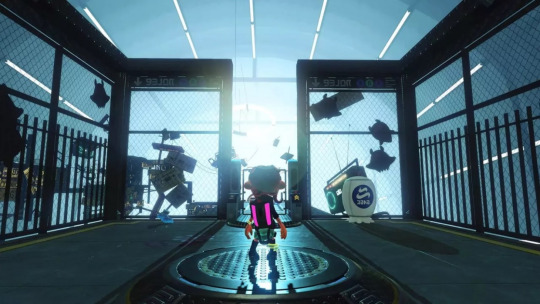
Splatoon has never been a series that people buy for the single player experience; the campaigns of 1 and 2 are not overly challenging, the rewards for completing them are underwhelming, and the levels are rarely interesting.
All this changed with the Octo Expansion. While first making a poor first impression with frustrating levels and a dreaded “pay to play” model (don’t worry, you use in-game currency only), the story mode ends up vastly outshining anything else the series has put forth, especially in the game’s final moments. Here are the 12 reasons why I loved the end of the Octo Expansion way more than I expected.
NOTE: Major spoilers for everything that follows your collection of the final “thang.”
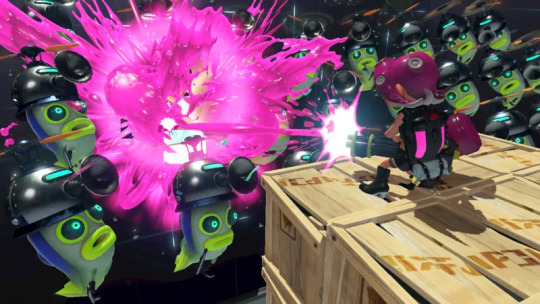
The Climax is Challenging but Not Overly Frustrating- I died, a lot, but always inched closer to victory. Plus, the game wisely stops requiring you to pay for continues in this final gauntlet of challenges.
The Story’s Resolution is Ominous- A sense of dread hangs over the game’s final levels. After nearly getting blendered to death (shudder), you begin your escape up to Inkopolis, but slowly realize that each level you are playing refers to internal organs, hinting that you are actually inside some massive creature
It Changes Things Up without Taking the Game off the Rails- Too many AAA titles decide to totally change the gameplay of the final battle, presumably to keep the player on their toes. However, this doesn’t ever feel all that satisfying. Octo Expansion’s final missions are thankfully no longer confined to isolated test chambers, but you are still using the skills and techniques you’ve mastered in the previous 80 levels.
Every Character Gets a Moment to Shine- (Except Captain Cuttlefish, which is honestly hilarious)
It Gradually Makes You Feel More and More Powerful- First you are weaponless. Then, you find grenades. Then a rifle. Soon you are zipping around with Jetpacks. It’s a wonderful slow build.

The Lore is Expanded in Fascinating Ways- Revealing the final villain to be a human (of sorts) literally made me gasp, and it was really nice to see Agent 2 from the first Splatoon back in action (even if he/she is an adversary)
It’s Not a Quick Time Event- These were really overdone for final battles a few years ago, in a lazy attempt to make everything more cinematic. Some games are still guilty of taking the easy way out.
It Puts Your Actual Splatoon Skills to the Test- The battle with a brainwashed Agent 2 made me feel like I was actually facing off against a super-powered online opponent. All my tricks I had mastered playing years of Turf War and Ranked Matches were finally put to good use. And the final battle being a bombastic version of Turf War (all the way down to the 3 minute timer) made the multiplayer and single player modes feel a little less disjointed.
It’s SO Anime- The giant human-statue about to annihilate all of Inkopolis while you zip around on rails and detonate super bombs all over its body is epic while still keeping the player in the driver’s seat

The Music is Just Perfect- An amazing remix of Ebb & Flow pumps you up for the showdown, and if you read all the chat logs you know how important this song is to Pearl and Marina’s friendship, adding one more layer of oomph to an already great track.
There are a ton of little details to appreciate- The way that the “Splatted Agent 2” icon pops up like it does in regular multiplayer matches. The realization that the doomsday weapon is a bunch of blenders fused together. The triumphant return of Killer Wail, and the way Pearl absolutely shatters the “GOOD GUYS v. BAD GUYS” meter. This game really rewards fans who are paying close attention.
It Feels Ultra Rewarding- When you are done watching the sunset with your brothers (and sisters) in arms, you are treated to a unique title screen: Inkopolis from the perspective of the subway entrance. Agent 8 has earned her freedom, and you the player have earned a new character race to play, and depending on how much of a completionist you are, up to 10 unique clothing items to take into online battles.

If every game had finales that accomplished these 12 achievements, I think we’d all be way more likely to finish what we start. Bravo, Hisashi Nogami. You and your team done good.
#splatoon 2#Splatoon#octo expansion#nintendo#nintendo swtich#online#video games#final boss#quick time events#woomy
54 notes
·
View notes
Link
At the end of last week, we finished up the Kickstarter campaign for the new Trinity Continuum core book, and the Trinity Continuum: Aeon book. We pretty much unlocked a Stretch Goal a day, and built out two PDFs for backers; an Aeon Aexpansion containing added info on more cool parts of the TC:Aeon setting, and In Media Res, a collection of adventure ideas for the TC core modern-day time period.
There are a few reasons why the results of this Kickstarter are satisfying to our crew here at Onyx Path:
1- The two books with the two extra PDFs give us a great start on the two time periods featured in the books. Now we can have a few meetings and discuss both the continuation of those two settings, and we can start looking at what other time periods we can cover soon. Which brings us to:
2- Based on the response to this latest KS, we are confident that we can put together a team ASAP to create the Trinity Continuum: Aberrant book, and plan on another Kickstarter for it when its text is done. Why then? Well:
3- All available evidence shows that allowing backers to read the finished text for a book being Kickstarted in weekly or two per week sections like we did for this and the last couple of KSs, does indeed give folks a chance to read, absorb, and discuss that section pretty well until the next section drops. Folks have something new to check out every couple of days. Finally:
4- With this Kickstarter, we have revealed to our community the last of the first slate of projects that came out of our initial plans for the worlds Onyx Path would publish. We, of course, have a whole bunch of new projects coming up that we’re thrilled to be starting on, or finalizing the plans for, but getting the three game-lines I bought from CCP (Scion, Scarred Lands, and the Trinity Universe) recreated and available in one form or the other for our community is a fine indicator of how we’ve thrived these last 6 years. (Heavy sigh of relief as it was never, and remains never, a slam-dunk that folks would dig what we’re doing).
And while we’ve been bringing the Storypath System and our own game-lines to life, we haven’t forgotten our Exalted 3rd, Chronicles of Darkness, and World of Darkness projects. In fact, I just sent a raft of project pitches over to White Wolf for approval. Some of them are projects that fans of those lines have heard of already (or at least the rumors of) and a couple are brand new.
More on those when we hear back from WW and can move on to outlining and getting writers a writin’.
Dragon Blooded illustration by Yihyoung Li
One thing we did not have in mind when we started was the ability to put together formats that creators in our community could use to make their own projects. I’m referring of course to Community Content programs, and our first is the one for Pugmire called Canis Minor that I announced a month and a half, give or take, ago.
We already have seven PDF projects up there, all either pay what you want or below $2.00 and it’s clear that the writers were just all having a blast exploring the world of Pugmire. A character creation guide, heroes and villains, a bunch of adventures, the list goes on.
And you can add to it if you have a yen to join our happy band of creators – the guidelines and formats are easy to follow, and you’ll retain half the earnings. Plus, Eddy Webb is a really nice guy and loves reading how folks have taken his ideas and run with them!
We’re finishing up the initial stages of our Scarred Lands Community Content site, and then we’ll be moving on to Scion, and we’re not done yet.
Night Horrors: Enemy Action illustration by Luis Sanz
Finally, I just want to briefly touch base on the Chronicles of Darkness‘s Night Horrors series of books – particularly since the one for Demon: The Descent, Night Horrors: Enemy Action, goes on sale this Wednesday. Long-time members of our community will recall that the Night Horrors “brand” was a sort of cross-line series of projects for the “new World of Darkness”, and were designed for one line but usable by all of the others.
With the advent of the Chronicles of Darkness, it made sense to me to bring back this popular series of antagonist books for the 2nd edition rules. Plus, the way the books present discrete write-ups for the various “baddies” is a great way for us to try out the new writers we’ve been looking to bring aboard for the last couple of years. If there’s a problem with a write-up, it’s just one creature, and not a huge word count to replace.
So go ahead and check out the blurbs in The Blurbs below and on DriveThru and see if there might not be some antagonists that could fit into your home chronicle, or be used to throw your players a surprise, even if that particular Night Horrors book isn’t from a line you’d normally play.
And with that, I’m outta here, and dropping this here motto right there:
Many Worlds, One Path!
BLURBS!
KICKSTARTER:
Our next Kickstarter is slated to be EX3‘s Dragon-Blooded near the end of March.
As we try and find ways to enable our community to more easily play our games, the Onyx Dice Rolling App is now live! Our dev team has been doing updates since we launched based on the excellent use-case comments by our community, and this thing is both rolling and rocking!
The devs have added a whole bunch of new game lines’ dice and rolling bg’s and got caught by a bug Apple needed to fix, so be sure to update your app and soon that should be fixed.
There’s been tweaks to all elements of the UI, you can now preview every die type in the store, and you can use multiple die types per roll! Here are the links for the Apple and Android versions:
http://theappstore.site/app/1296692067/onyx-dice
https://play.google.com/store/apps/details?id=com.onyxpathpublishing.onyxdice&hl=en
Three different screenshots, above.
(The Solar Anima special Dice above)
Promethean: The Created and Demon: The Descent dice on a Demon: The Descent tabletop
Hunter: The Reckoning and Mage: The Awakening dice on a Mage: The Awakening tabletop
ON AMAZON AND BARNES & NOBLE:
We’re delighted to announce the opening of our ebook stores on Amazon and Barnes & Noble! You can now read our fiction from the comfort and convenience of your Kindle (from Amazon) and Nook (from Barnes & Noble). Our initial selection includes these fiction anthologies:
Vampire: The Masquerade: The Endless Ages Anthology (Kindle, Nook)
Werewolf: The Apocalypse: Rites of Renown: When Will You Rage II (Kindle, Nook)
Mage: The Ascension: Truth Beyond Paradox (Kindle, Nook)
Chronicles of Darkness: The God-Machine Chronicle Anthology (Kindle, Nook)
Mummy: The Curse: Curse of the Blue Nile (Kindle, Nook)
Beast: The Primordial: The Primordial Feast Anthology (Kindle, Nook)
And here are six more fiction books:
Vampire: The Masquerade: Of Predators and Prey: The Hunters Hunted II Anthology (Kindle, Nook)
Werewolf: The Apocalypse: The Poison Tree (Kindle, Nook)
Werewolf: The Apocalypse: Songs of the Sun and Moon: Tales of the Changing Breeds (Kindle, Nook)
Vampire: The Requiem: The Strix Chronicle Anthology (Kindle, Nook)
Werewolf: The Forsaken: The Idigam Chronicle Anthology (Kindle, Nook)
Mage: The Awakening: The Fallen World Chronicle Anthology (Kindle, Nook)
Andand six more more:
Vampire: The Masquerade: The Beast Within Anthology (Kindle, Nook)
Werewolf: The Apocalypse: W20 Cookbook (Kindle, Nook)
Exalted: Tales from the Age of Sorrows (Kindle, Nook)
Chronicles of Darkness: Tales of the Dark Eras (Kindle, Nook)
Promethean: The Created: The Firestorm Chronicle Anthology (Kindle, Nook)
Demon: The Descent: Demon: Interface (Kindle, Nook)
And even more books are now on Amazon and the Nook store!:
Scarred Lands: Death in the Walled Warren (Kindle, Nook)
V20 Dark Ages: Cainite Conspiracies (Kindle, Nook)
Chronicles of Darkness: Strangeness in the Proportion (Kindle, Nook)
Vampire: The Requiem: Silent Knife (Kindle, Nook)
Mummy: The Curse: Dawn of Heresies (Kindle, Nook)
OUR SALES PARTNERS:
We’re working with Studio2 to get Pugmire out into stores, as well as to individuals through their online store. You can pick up the traditionally printed main book, the Screen, and the official Pugmire dice through our friends there!
https://studio2publishing.com/search?q=pugmire
Looking for our Deluxe or Prestige Edition books? Here’s the link to the press release we put out about how Onyx Path is now selling through Indie Press Revolution: http://theonyxpath.com/press-release-onyx-path-limited-editions-now-available-through-indie-press-revolution/
You can now order wave 2 of our Deluxe and Prestige print overrun books, including Deluxe Mage 20th Anniversary, and Deluxe V20 Dark Ages! And Screens…so many Screens!
And you can now order Pugmire: the book, the screen, and the dice! http://www.indiepressrevolution.com/xcart/manufacturers.php?manufacturerid=296
DRIVETHRURPG.COM:
Ask the darkness, and it shall answer: the Beast: The Primordial Player’s Guide Advance PDF will answer your questions when it goes live on DTRPG.com this Wednesday!
The Beast Player’s Guide expands on the material presented in Beast: The Primordial, with additional information on the Families and Hungers, what it feels like to be a Beast and experience the Devouring, and how to commune with the Dark Mother. You’ll also find two new Families and two new Hungers!
The book also includes a plethora of new Atavisms, Nightmares, Merits, and Birthrights, as well as systems for creating smaller, subservient versions of the Horror, new forms of Inheritance, and details on the mysterious Obcasus Rites.
There are some things that even a Demon fears – Night Horrors: Enemy Action for Demon: The Descent arrives as an Advance PDF this Wednesday on DTRPG.com!
“Fighting the Machine is like fighting the ocean. You literally cannot hurt it. Doesn’t matter how much poison we dump into the ocean. We’ll only kill the things in it. We’ll never kill it. Same with the God-Machine. Kill angels, traitors, stigmatics, cultists, cryptids, whatever, you’ll never hurt the Machine Itself. No, that doesn’t mean we stop trying. You stop trying, you drown. Screw that.”
—Mr. Bliss, Guardian Inquisitor
Night Horrors: Enemy Action includes:
• Dozens of Storyteller characters, including Unchained, angels, exiles, cryptids, and stigmatics, for use as antagonists, allies, or just inspiration
• Multiple plot hooks and story seeds for your Demon: The Descent chronicles
• A brief look at cults in Demon, including the Ten Thousand Names of God, a secret society fueled by the God-Machine
With a howl of RAGE, the W20 Changing Ways PDF and physical book PoD charges at you this Wednesday on DTRPG.com! http://www.drivethrurpg.com/product/229183/W20-Changing-Ways
Changing Ways is an in-depth look at what it means to be a werewolf, both on a personal level and as part of a pack. It digs deep into what it feels like to have bones re-knit after breaking, the range of senses available across all forms, and the sudden heady rush of the Gifts and Rites bestowed by spirits. It also provides a look at what life is like for lupus and metis werewolves, characters who have had experiences alien to any person. It shows the many ways that werewolves organize in packs, and how those packs are designed as groups of warriors, rather than aligned to the behavior of wolves.
Changing Ways contains:
• A detailed look at what it means to grow up as a lupus or metis werewolf, and how that colors a character’s perspective.
• More information on what it feels like to be a werewolf, a creature that changes in both body and mind.
• Frameworks and organizations for packs, along with new tactics and systems for forging the pack as part of play.
Appearing on DriveThruRPG this Wednesday are the PDF and PoD physical book versions of Arms of the Chosen for Exalted 3rd Edition! http://www.drivethrurpg.com/product/226224/Arms-of-the-Chosen
Take up the panoply of legendary heroes and lost ages, and awaken the world-shaking might of their Evocations. Before the dawn of time, the Exalted wielded god-metal blades to cast down the makers of the universe. In an ancient epoch of forgotten glories, Creation’s greatest artificers forged unimaginable wonders and miracle-machines.
Now, in the Age of Sorrows, kingdoms go to war over potent artifacts, scavenger princes risk everything to uncover relics of the past, and the Exalted forge great arms and armor on the anvil of legend. These treasures are yours to master.
Discover the mystical power of the five magical materials and the secrets of creating your own Evocations. Wield weapons of fabled might and don the armor of mythic heroes, making their puissance your own. Claim Creation’s wonders: the miraculous tools of the Chosen, living automatons, flying machines, hearthstones, and more. And unleash the mighty warstriders, titanic god-engines of conquest and devastation, to once more shake Creation with their footfalls.
Coming this Wednesday as an Advance PDF on DTRPG, we reveal The Secret of Vinsen’s Tomb, a Jumpstart adventure for Pugmire. (And yes, there will be a physical book PoD version coming soon). www.drivethrurpg.com/product/232337/The-Secrets-of-Vinsens-Tomb–A-Pugmire-Jumpstart
A cat living in Pugmire disappears, but neither the police dogs nor the cats of the Cat Quarter know why. When zombies attack the heroes, however, all signs point to an invasion by the Monarchies of Mau. But how does this intrigue tie into the lost tomb of the first king of Pugmire?
The Secret of Vinsen’s Tomb is a Pugmire story for three to six characters. This jumpstart contains all the rules and characters you need to play — just grab some dice and go! You can also use this adventure with the full version of Pugmire.
The Secret of Vinsen’s Tomb contains:
• An evocative and mysterious setting that’s both family friendly and deep enough to create compelling stories.
• A summary of Pugmire’s traditional fantasy rules system. It’s designed for streamlined play, with an emphasis on cooperation and action over competition and violence.
• A complete adventure for a Guide to run for three to six players. Also useful for Guides running a full Pugmire game of first or second level characters!
• Six ready-to-play characters, so you can jump into the action.
Can your good dogs discover the secret of Vinsen’s Tomb?
Also releasing this Wednesday on DTRPG is the physical book PoD version of the Pugmire Core Rulebook itself!
We unveil Vampire: The Requiem 2e‘s Half-Damned as PDF and PoD versions on DTRPG.com this Wednesday!
http://www.drivethrurpg.com/product/227500/Half-Damned
I love her, she’s family, but I don’t love what she is.
– Antonio Ramírez, dhampir
This book includes:
• An exploration of what it means to be one of the Half-Damned, dhampir, revenants or ghouls.
• Mechanics for creating Half-Damned characters.
• Information for creating and running chronicles using the various Half-Damned character types, both with vampires and alone.
• Information on Half-Damned antagonists for vampire chronicles.
A Land Where Legends Walk
Drawing enthusiastically on Greek mythology, the revised and re-imagined Scarred Lands nonetheless retains its place as a modern fantasy RPG setting. This is a world shaped by gods and monsters, and only the greatest of heroes can expect to be counted among them. The most populous continent of Scarn, Ghelspad, plays host to vast unexplored regions, hides unsolved riddles from ancient cultures, and taunts adventures with the promise of undiscovered riches hidden among the ruins of older civilizations.
Yet the myths of the Scarred Lands are relatively recent events. The effects of the Titanswar still ripple through the world, and the heroines and villains of many of these stories are part of living memory, if not still living.
The Award-Winning Fantasy Setting Returns
Scarred Lands has been a favorite fantasy setting since the release of the Creature Collection for the d20 System in 2000. In subsequent years, over 40 titles were published for Scarred Lands, making it one of the most fully supported fantasy RPG settings ever and the premiere product line of Sword & Sorcery Studios.
Available in both 5th Edition and Pathfinder compatible versions! PDF and PoD formats available NOW!
http://www.drivethrurpg.com/product/193014/Scarred-Lands-Players-Guide-Pathfinder
http://www.drivethrurpg.com/product/197803/Scarred-Lands-Players-Guide-OGL-5e
CONVENTIONS!
And now, the new project status updates!
DEVELOPMENT STATUS FROM FAST EDDY WEBB (projects in bold have changed status since last week):
First Draft (The first phase of a project that is about the work being done by writers, not dev prep)
M20 Gods and Monsters (Mage: the Ascension 20th Anniversary Edition)
M20 Book of the Fallen (Mage: the Ascension 20th Anniversary Edition)
C20 Novel (Jackie Cassada) (Changeling: the Dreaming 20th Anniversary Edition)
Deviant: The Renegades (Deviant: The Renegades)
CofD Contagion Chronicle (Chronicles of Darkness)
M20 The Technocracy Reloaded (Mage: the Ascension 20th Anniversary Edition)
M20 Victorian Mage (Mage: the Ascension 20th Anniversary Edition)
Dystopia Rising: Evolution (Dystopia Rising: Evolution)
Spilled Blood (Vampire: The Requiem 2nd Edition)
CofD Dark Eras 2 (Chronicles of Darkness)
Redlines
Guide to the Night (Vampire: The Requiem 2nd Edition)
Second Draft
WoD Ghost Hunters (World of Darkness)
Tales of Good Dogs – Pugmire Fiction Anthology (Pugmire)
Development
Signs of Sorcery (Mage: the Awakening Second Edition)
GtS Geist 2e core (Geist: the Sin-Eaters Second Edition)
Night Horrors: The Tormented (Promethean: The Created 2nd Edition)
Hunter: the Vigil 2e core (Hunter: the Vigil 2nd Edition)
Fetch Quest (Pugmire)
They Came From Beneath the Sea! Rulebook (TCFBtS!)
WW Manuscript Approval:
Editing:
Ex Novel 2 (Aaron Rosenberg) (Exalted 3rd Edition)
Exalted 3rd Novel by Matt Forbeck (Exalted 3rd Edition)
Trinity Continuum: Aeon Rulebook (The Trinity Continuum)
Monarchies of Mau (Monarchies of Mau)
Post-Editing Development:
Changeling: the Lost 2nd Edition, featuring the Huntsmen Chronicle (Changeling: the Lost 2nd Edition)
Dragon-Blooded (Exalted 3rd Edition)
Pan’s Guide for New Pioneers (Pugmire)
The Realm (Exalted 3rd Edition)
Kithbook Boggans (Changeling: the Dreaming 20th Anniversary Edition)
Scion: Hero (Scion 2nd Edition)
Trinity Continuum Core Rulebook (The Trinity Continuum)
Indexing:
ART DIRECTION FROM MIRTHFUL MIKE:
In Art Direction
Ex3 Monthly Stuff
Scion Hero
Changeling: the Lost 2 – Art is contracted.
Trinity Continuum
Ex3 Dragon Blooded
Boggans – Contracted.
Monarchies of Mau – Sorting through buy and figuring out roster.
Fetch Quest – KS art contracted. Taking some time this week to tweak the card design.
Marketing Stuff
In Layout
Scarred Lands Community Content –Figuring out the covers and the Slarecian Vault Logo.
Scion Origin
Wraith 20 Screen – Front approved… now waiting for errata phase to assemble all the charts.
Cavaliers of Mars – Laying out while new art coming in.
Proofing
Book of Freeholds – Maggie has 2nd proof.
Pugmire – Pan’s Explorer’s Guide (or whatever)
At Press
Beckett Screen – Shipped to shipper.
Scarred Land PGs & Wise and the Wicked PF & 5e – To fulfillment shipper. PDF and PoD physical book versions on sale at DTRPG.
Changeling: the Dreaming 20th Anniversary Edition (Changeling: the Dreaming 20th Anniversary Edition) – Books and Screens created and preparing to ship from printer to fulfillment shipper.
Prince’s Gambit – At press.
V20 Beckett’s Jyhad Diary– Deluxe edition files sent to printer.
C20 Ready Made Characters – PoD proofs on the way.
Pugmire Artisan Cards – PoD proofs on the way.
Pugmire Shepherd Cards – PoD proofs on the way.
Scion Dice Packaging – At press.
Wraith 20 – Backer PDF out, and errata is coming in.
Ring of Spiragos – PoD proofs on their way.
Pugmire Vinsen’s Tomb – PoD proofs on the way.
Beast PG – Advance PDF on sale at DTRPG.com this Wednesday.
DtD Enemy Action – Advance PDF on sale at DTRPG.com this Wednesday.
TODAY’S REASON TO CELEBRATE: In the US, March has indeed come in like a lion and we’ll see if it goes out like a lamb. But: “Now look, pal! I know a country where March comes in like an emu and goes out like a tapir. And they don’t even know what it means! All right? Now listen, there are nine different countries, where March comes in like a frog, and goes out like a golden retriever. But that- that’s not the weird part! No, no, the weird part is, is the frog. The frog- The weird part is-[has seizure and falls off chair]”
4 notes
·
View notes
Text
Game Dev Update | 6.9.17
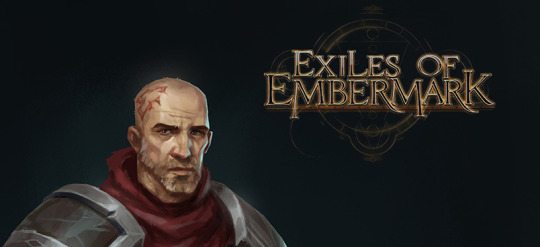
Who is that? What’s he so sad about? What’s that on his head? Read on...
Welcome back to the Exiles Game Dev Update, wherein we cover all things happening in the world of the game and its development.
Last time, we covered a bunch of content, gameplay experiments and visual evolutions on the Exiles UI. This Update goes across the board with a look at the way we’re setting up battle environments, a new NPC, lootz (as always) and an introduction to the fellow that will guide you through your early experiences in Embermark.
ENVIRONMENT BREAKDOWN: VANISIR
We’ve mostly shown our classic foresty Wildewoods battle environment in the past (or the Arena), but we’ve been quietly working on many different Battle setups for different Zones and situations all the while. This time, let’s take a look at Vanisir, the southwest Zone known for arid land and DANGER (ok, fine, every Zone in Embermark is dangerous-- it’s a fantasy-post-apocalyptic landscape after all). You can see from this setup that we’re taking several 2D paintings and arranging them in UE4 to achieve our 3D-but-hand-painted look:
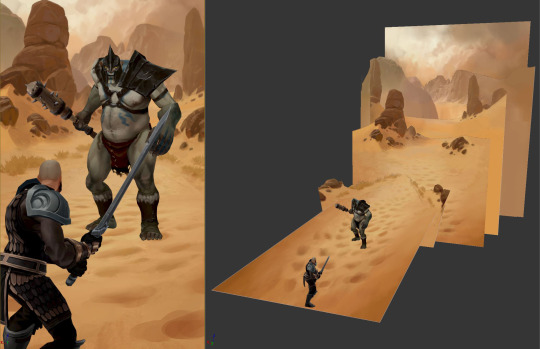
AMA TRANSCRIPT
We had a rousing discussion in our 2nd-of-many Ask Me Anything a few weeks ago on the Exiles Discord Channel, with subjects ranging from Abilities to Stats to World Events & Houses tackled. Besides lively banter, several Exiles won coveted items when the game launches via “rolls” in chat.
In case you missed it and want to get all the info & shenanigans, you can find the entirety of it here for posterity (our gratitude goes out to community stalwart Drakythe for capturing the AMA and posting the transcript).
BANDITS!
A Faction exists in Embermark that doesn’t really acknowledge (or respect) any leadership other than its own-- the Raiders. If called to fight as a unit or untied Faction, they probably wouldn’t fare well, but when encountered in Quests or random encounters in Exiles, they can be deadly.
Of medium build and questionable (read: awful) morals, the bandit can be found in Wildewoods and Askala among other Zones.
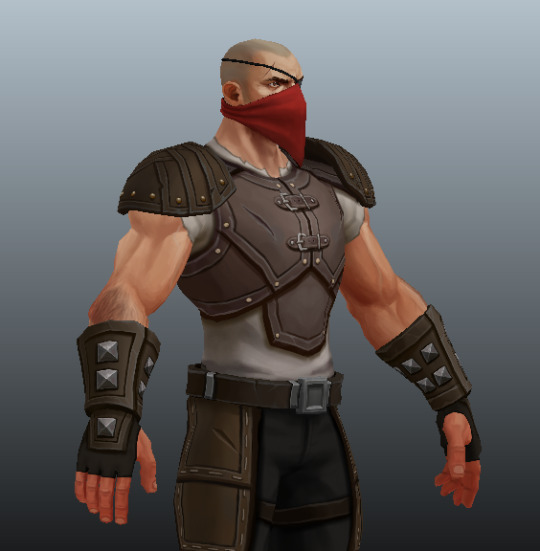
Don’t like the red bandanna? FINE...
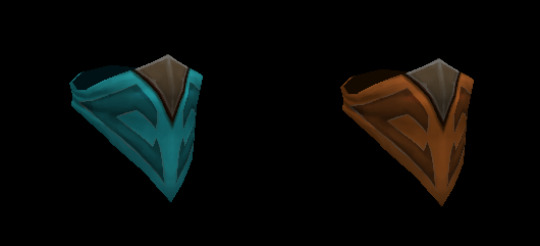
Now, a significant constituency of the Exiles community are Rogue-friendly (yes, that is a term), and I’m not saying this Bandit here is reminiscent of what you might expect your player-Rogue to be like... OR AM I.
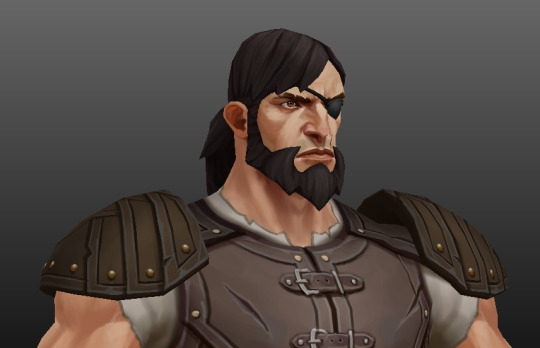
What I can say is that because we’re using the player models for creation of NPCs, we have the ability to appropriate their equipment for YOU. So a shout-out to you Rogue-friendlies out there-- consider this gear a bit of a preview to what kind of gear you might outfit yourself when gameday comes...
ABILITIES UI REDESIGN
UI 2.0 is on its way as we watch people play the game and discover optimizations ourselves. One we attacked this month is the switching of Ability Sets (remember, Ability Sets in Exiles can be 4 Abilities in the basic combat we’re testing and 8 in the “Deck” version we’re also testing). Using a list view to toggle between what becomes quite a few saved Ability Sets for an advanced player becomes cumbersome, so we added in some additional options for ease of use:
Ability Set title at the top
Arrows (and swipe, of course) for switching between your saved Ability Sets
Pips below the current Ability Set to show both which one is active and how many you have
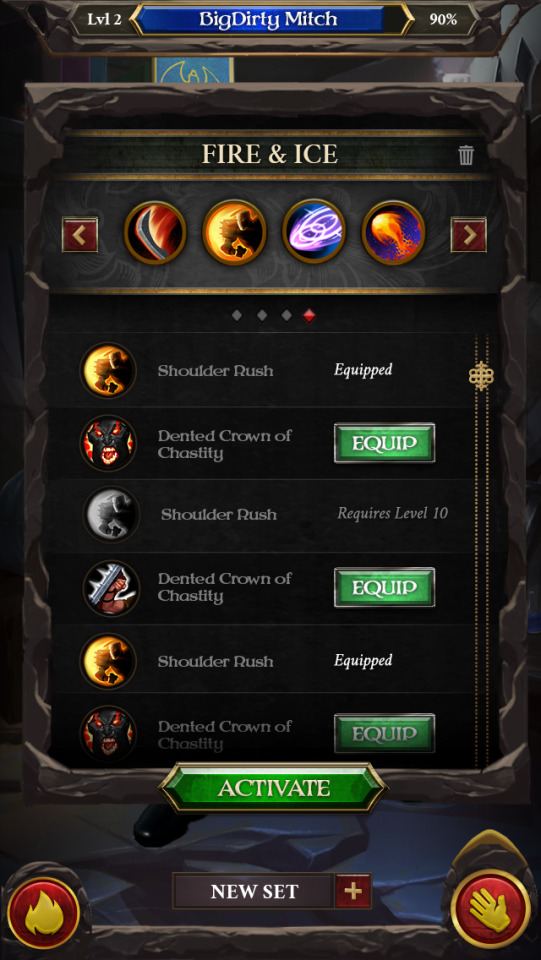
This underscores some things that we’re experiencing in play sessions
THE ELF IN ACTION
We’ve shown the evolution of Exiles’ wood elf characters since the beginning of this project (here, here & here), so having him in the game now is really exciting for us. We’re doing a little extra fudge factor to get his arrow to do different things (stay tuned for additional VFX we’re working on), but you can see his Sharpshot Ability here:

With a sideview of same here:

And Gunslinger’s animator-extraordinaire Andrew even used the arrow as a comedy device in the elf’s death:
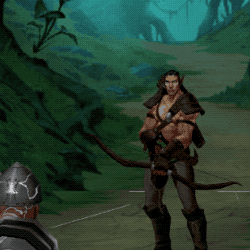
Found all over, but concentrated in Wildewoods, Feral Moon and Askala, these wood elves are no fans of their brethren in the southern island Zone of Queviel. Those elves made an exodus during the Collapse to get away from the destruction, leaving their wood elf cousins to fend, adapt and evolve into the wilder, more martial elves that you will encounter often.
HELMS & TELLS & TUNICS
Each month, we increase the Exiles library of loot and show a few choice pieces to illustrate both our stylistic choices as well as our experiments in gameplay. As we turned the dwarf I showed last month into a formidable foe (and sometimes ally), his gear was adapted into player-wearable items, and we gave it the color-tell treatment (go here for explanation). We’re in the process of figuring out how far we need to go to get the effects telegraph across to players, cuz where this helmet definitely says “green” to the opponent...
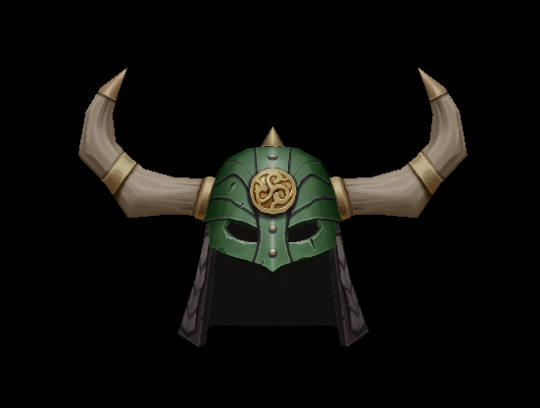
...this one has a certain style...

You’ll see where we landed when closed testing begins, and I will likely address this whole system in a later update.
It also occurred to me that we’ve never shown (or even mentioned) TUNICS before, and what’s a fantasy RPG without that word (or item)? Well, it’s not going to deflect much in the way of damage, but here are three tiers of a mage tunic for your wearing pleasure:

And of course, the latest in power-fashion magery:
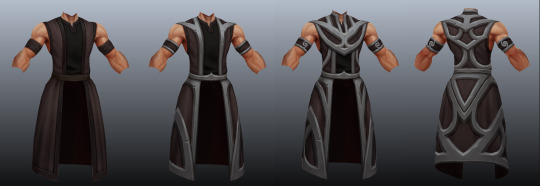
All of the items that I’ve shown in the last few updates are now in the game, and we’ve been upgrading and improving our backend system that pushes content into the game in real-time. I’ll be starting to post video of more extended gameplay and battles once we get more finish on the feedback systems, but for now, take a look at another GIF of equipping, featuring the Spear, Axe, Shield and armor set show in the past 2 or 3 updates. Please note the now-working rarity icons!:

(click here for a much longer and better GIF unbound by Tumblr’s file size limits)
THE NARRATOR (& HIS MANY HIDDENS)
The backstory and Lore of Exiles has been a fun and evolving part of the project, and as the preview stories started coming together with Bound, we realized the need for creating a character who acts as the voice (check out the Pocket Gamer article on Bound’s announcement of award-winning writer Andrew Saxsma as the talespinner on Exiles). We needed bit of a narrator. So we went through a process of coming up with who/what we wanted him to be and do. We went through many iterations of look and feel and reference to get something that nailed the tone of someone who would engage in telling you these stories...

(With great respect to GRRM, who sees Jorah Mormont in the above? Which one?)
Then we started playing with the type of fellow he might be, what he would be equipped to do, to survive and to know...

Until we arrived at a backstory and personality that we’re pretty excited about, but...
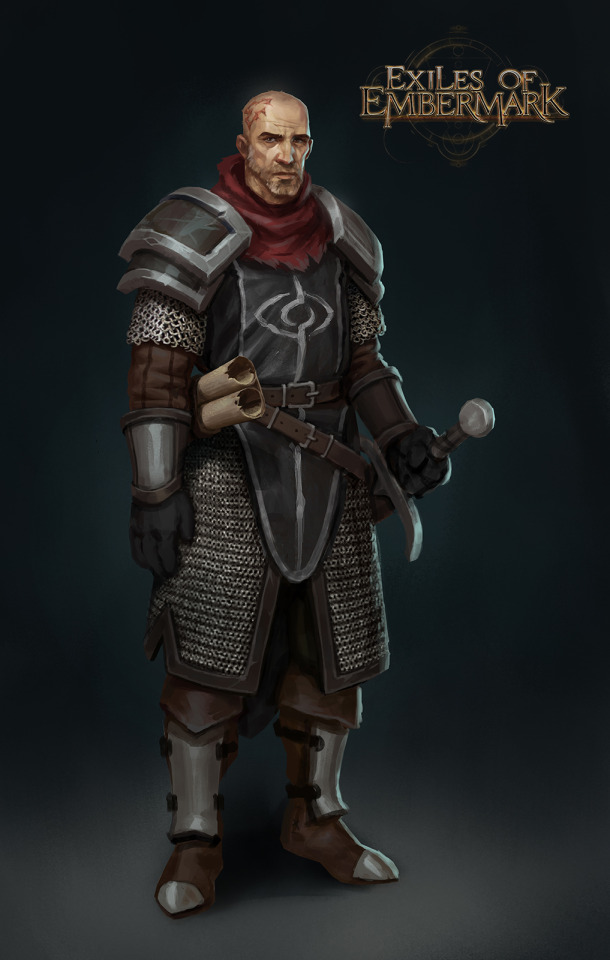
...then we SHROUDED HIM IN MYSTERY.
Har. So I’ll say little else other than there are no less than 2 major signals about who and what our Narrator is in this illustration. We shall reveal those items in due time. For now, I give you:
NARRATIVE - A GLIMPSE
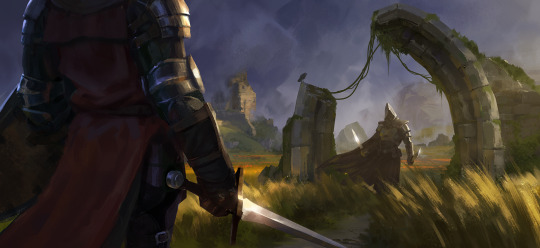
There are quite a few episodes of the Exiles storyline in the can now. If you’re just joining us, we’re telling some of the backstory of the game before it’s available, and once the game launches, we’ll be telling the story of YOU. By that, I mean we’ll be reporting on the storyline as players play out their adventures, using the data from the game and the choices you make to direct the ongoing narrative.
Very soon, our friends at Bound will release early episodes of the backstory (told by our haunted friend above), so now-- have a read through of the very first mid-episode snippet from our coming Tales...
A farmhand and his wife, who had been pulling behind them the few belongings left of their home, mentioned in passing that there had been an attack against House Resolute that morning, before the sun had risen.
They described a horror of the loudest thunder and the hottest fires that rained down from the skies over the gulley of central Siege, barraging the fortress at its heart. Mages, it was rumored, of a rival House had rallied against the hoarding House Resolute. These Mages, I learned, wanted retribution for the deprived territories and as I neared the mountain’s peak, I witnessed fires devouring the countryside and ash falling as snow from bloated dark clouds.
Though Hurinyl withstood its aggressors, neighboring encampments were leveled and homes and farmland for miles vanished.
More troubling was that a message of blood and destruction was delivered that morning, one which would resound for ages to follow. That message, my friend, was quite clear: Man had lost his abundance, his satisfaction. His eyes, and all they desired, had turned upon his neighbor.
The rise of the Houses was signaled. War was coming.
What?! What was Resolute hoarding? What mages? Who’s the “bad guy?” Who had the power to engulf the whole countryside? Stay tuned, Exiles...
REMEMBER
We’ll keep sharing details as we head into testing (remember to PM TheWizard on the Exiles forums with your device type if you want in on closed testing & beta later), and you can count on early impressions from the testers throughout our various channels.
If you haven’t already, follow along with the Exiles development on Twitter, Instagram and Facebook. And if you haven’t, I’ll find you. And SMITE you.
THERE’S CHAT CHATTER EVERYDAY AS WE READY TO BATTLE
If you want to hear about the game, ask questions or connect with others who are helping the development team think about features, design and narrative, hop into the Discord Channel for live chat and say hi– it’s a friendly lot with plenty of daily shenanigans (there’s even a Shenaniganizer).
THE BONUS: A TURNAROUND
Lots of “Fs” in this one...
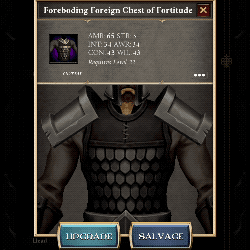
3 notes
·
View notes
Text
Starting with OpenCV on i.MX 6 Processors
Introduction
As the saying goes, a picture is worth a thousand words. It is indeed true to some extent: a picture can hold information about objects, environment, text, people, age and situations, among other information. It can also be extended to video, that can be interpreted as a series of pictures and thus holds motion information.
This might be a good hint as to why computer vision (CV) has been a field of study that is expanding its boundaries every day. But then we come to the question: what is computer vision? It is the ability to extract meaning from an image, or a series of images. It is not to be confused with digital imaging neither image processing, which are the production of an input image and the application of mathematical operations to images, respectively. Indeed, they are both required to make CV possible.
But what might be somehow trivial to human beings, such as reading or recognizing people, is not always true when talking about computers interpreting images. Although nowadays there are many well known applications such as face detection in digital cameras and even face recognition in some systems, or optical character recognition (OCR) for book scanners and license plate reading in traffic monitoring systems, these are fields that nearly didn't exist 15 years ago in people's daily lives. Self-driving cars going from controlled environments to the streets are a good measure of how cutting-edge this technology is, and one of the enablers of CV is the advancement of computing power in smaller packages.
Being so, this blog post is an introduction to the use of computer vision in embedded systems, by employing the OpenCV 2.4 and 3.1 versions in Computer on Modules (CoMs) equipped with NXP i.MX 6 processors. The CoMs chosen were the Colibri and Apalis families from Toradex.
OpenCV stands for Open Source Computer Vision Library, which is a set of libraries that contain several hundreds of computer vision related algorithms. It has a modular structure, divided in a core library and several others such as image processing module, video analysis module and user interface capabilities module, among others.
Considerations about OpenCV, i.MX 6 processors and the Toradex modules
OpenCV is a set of libraries that computes mathematical operations on the CPU by default. It has support for multicore processing by using a few external libraries such as OpenMP (Open Multi-processing) and TBB (Threading Building Blocks). This blog post will not go deeper into comparing the implementation aspects of the choices available, but the performance of a specific application might change with different libraries.
Regarding support for the NEON floating-point unit coprocessor, the release of OpenCV 3.0 states that approximately 40 functions have been accelerated and a new HAL (hardware abstraction layer) provides an easy way to create NEON-optimized code, which is a good way to enhance performance in many ARM embedded systems. I didn't dive deep into it, but if you like to see under the hood, having a look at the OpenCV source-code (1, 2) might be interesting.
This blog post will present how to use OpenCV 2.4 and also OpenCV 3.1 - this was decided because there might be readers with legacy applications that want to use the older version. It is a good opportunity for you to compare performance between versions and have a hint about the NEON optimizations gains.
The i.MX 6 single/dual lite SoC has graphics GPU (GC880) which supports OpenGL ES, while the i.MX 6 dual/quad SoC, has 3D graphics GPU (GC2000) which supports OpenGL ES and also OpenCL Embedded Profile, but not the Full Profile. The i.MX 6 also has 2D GPU (GC320), IPU and, for the dual/quad version, vector GPU (GC335), but this blog post will not discuss the possibility of using these hardware capabilities with OpenCV - it suffices to say that OpenCV source-code does not support them by default, therefore a considerable amount of effort would be required to take advantage of the i.MX 6 hardware specifics.
While OpenCL is a general purpose GPU programming language, its use is not the target of this blog post. OpenGL is an API for rendering 2D and 3D graphics on the GPU, and therefore is not meant for general purpose computing, although some experiments (1) have demonstrated that it is possible to use OpenGL ES for general purpose image processing, and there is even an application-note by NXP for those interested. If you would like to use GPU accelerated OpenCV out-of-the-box, Toradex has a module that supports CUDA – the Apalis TK1. See this blog post for more details.
Despite all the hardware capabilities available and possibly usable to gain performance, according to this presentation, the optimization of OpenCV source-code focusing only software and the NEON co-processor could yield a performance enhancement of 2-3x for algorithm and another 3-4x NEON optimizations.
The Images 1 and 2 present, respectively, the Colibri iMX6DL + Colibri Evaluation Board and the Apalis iMX6Q + Apalis Evaluation Board, both with supply, debug UART, ethernet, USB camera and VGA display cables plugged in.

Colibri iMX6DL Colibri Evaluation Board setup

Apalis iMX6Q Apalis Evaluation Board setup
It is important to notice that different USB camera models had a performance offset, and that the camera employed in this blog post is a generic consumer camera – the driver was listed as “Aveo Technology Corp”. There are also professional cameras in the market, USB or not, such as the solutions provided by Basler AG, that are meant for embedded solutions when going to develop a real-world solution.

Professional camera from Basler AG
In addition, Toradex has the CSI Camera Module 5MP OV5640. It is an add-on board for the Apalis computer-on-module which uses MIPI-CSI Interface. It uses the OmniVision OV5640 camera sensor with built-in auto-focus. The OV5640 image sensor is a low voltage, high-performance, 1/4-inch 5 megapixel CMOS image sensor that provides the full functionality of a single chip 5 megapixel (2592x1944) camera. The CSI Camera Module 5MP OV5640 can be connected to the MIPI-CSI connector on the Ixora carrier board V1.1 using a 24 way 0.5mm pitch FFC cable.

Toradex CSI Camera Module 5MP OV5640
At the end of this blog post, a summary of the instructions to install OpenCV and deploy applications to the target is provided.
Building Linux image with OpenCV
Images for the OpenCV 2.4 and 3.1 are built with OpenEmbedded. You may follow this article to set up your host machine. The first step required is to install the system prerequisites for OpenEmbedded. Below an example is given for Ubuntu 16.04 - for other versions of Ubuntu and Fedora, please refer to the article link above:
sudo dpkg --add-architecture i386 sudo apt-get update sudo apt-get install g++-5-multilib sudo apt-get install curl dosfstools gawk g++-multilib gcc-multilib lib32z1-dev libcrypto++9v5:i386 libcrypto++-dev:i386 liblzo2-dev:i386 libstdc++-5-dev:i386 libusb-1.0-0:i386 libusb-1.0-0-dev:i386 uuid-dev:i386 cd /usr/lib; sudo ln -s libcrypto++.so.9.0.0 libcryptopp.so.6
The repo utility must also be installed, to fetch the various git repositories required to build the images:
mkdir ~/bin export PATH=~/bin:$PATH curl http://commondatastorage.googleapis.com/git-repo-downloads/repo > ~/bin/repo chmod a+x ~/bin/repo
Let's build the images with OpenCV 2.4 and 3.1 in different directories. If you are interested in only one version, some steps might be omitted. A directory to share the content downloaded by OpenEmbedded will also be created:
cd mkdir oe-core-opencv2.4 oe-core-opencv3.1 oe-core-downloads cd oe-core-opencv2.4 repo init -u http://git.toradex.com/toradex-bsp-platform.git -b LinuxImageV2.6.1 repo sync cd ../oe-core-opencv3.1 repo init -u http://git.toradex.com/toradex-bsp-platform.git -b LinuxImageV2.7 repo sync
OpenCV 2.4
OpenCV 2.4 will be included in the Toradex base image V2.6.1. Skip this section and go to the OpenCV3.1 if you are not interested in this version. The recipe included by
default uses the version 2.4.11 and has no support for multicore processing included.
Remove the append present in the meta-fsl-arm and the append present in the meta-toradex-demos:
rm layers/meta-fsl-arm/openembedded-layer/recipes-support/opencv/opencv_2.4.bbappend rm layers/meta-toradex-demos/recipes-support/opencv/opencv_2.4.bbappend
Let's create an append to use the version 2.4.13.2 (latest version so far) and add TBB as the framework to take advantage of multiple cores. Enter the oe-core-opencv2.4 directory:
cd oe-core-opencv2.4
Let's create an append in the meta-toradex-demos layer (layers/meta-toradex-demos/recipes-support/opencv/opencv_2.4.bbappend) with the following content:
gedit layers/meta-toradex-demos/recipes-support/opencv/opencv_2.4.bbappend ------------------------------------------------------------------------------------- SRCREV = "d7504ecaed716172806d932f91b65e2ef9bc9990" SRC_URI = "git://github.com/opencv/opencv.git;branch=2.4" PV = "2.4.13.2+git${SRCPV}" PACKAGECONFIG += " tbb" PACKAGECONFIG[tbb] = "-DWITH_TBB=ON,-DWITH_TBB=OFF,tbb,"
Alternatively, OpenMP could be used instead of TBB:
gedit layers/meta-toradex-demos/recipes-support/opencv/opencv_2.4.bbappend ------------------------------------------------------------------------------------- SRCREV = "d7504ecaed716172806d932f91b65e2ef9bc9990" SRC_URI = "git://github.com/opencv/opencv.git;branch=2.4" PV = "2.4.13.2+git${SRCPV}" EXTRA_OECMAKE += " -DWITH_OPENMP=ON"
Set up the environment before configuring the machine and adding support for OpenCV. Source the export script that is inside the oe-core-opencv2.4 directory:
. export
You will automatically enter the build directory. Edit the conf/local.conf file to modify and/or add the variables below:
gedit conf/local.conf ------------------------------------------------------------------------------- MACHINE ?= "apalis-imx6" # or colibri-imx6 depending on the CoM you have # Use the previously created folder for shared downloads, e.g. DL_DIR ?= "/home/user/oe-core-downloads" ACCEPT_FSL_EULA = "1" # libgomp is optional if you use TBB IMAGE_INSTALL_append = " opencv opencv-samples libgomp"
After that you can build the image, which takes a while:
bitbake –k angstrom-lxde-image
OpenCV 3.1
OpenCV 3.1 will be included in the Toradex base image V2.7. This recipe, different from the 2.4, already has TBB support included. Still, a compiler flag must be added or the compiling process will fail. Enter the oe-core-opencv3.1 directory:
cd oe-core-opencv3.1
Create a recipe append (layers/meta-openembedded/meta-oe/recipes-support/opencv/opencv_3.1.bb) with the following contents:
gedit layers/meta-toradex-demos/recipes-support/opencv/opencv_3.1.bbappend ------------------------------------------------------------------------------------- CXXFLAGS += " -Wa,-mimplicit-it=thumb"
Alternatively, OpenMP could be used instead of TBB. If you want to do it, create the bbappend with the following contents:
gedit layers/meta-toradex-demos/recipes-support/opencv/opencv_3.1.bbappend ------------------------------------------------------------------------------------- CXXFLAGS_armv7a += " -Wa,-mimplicit-it=thumb" PACKAGECONFIG_remove = "tbb" EXTRA_OECMAKE += " -DWITH_OPENMP=ON"
Set up the environment before configuring the machine and adding support for OpenCV. Source the export script that is inside the oe-core-opencv3.1 directory:
. export
You will automatically enter the build directory. Edit the conf/local.conf file to modify and/or add the variables below:
gedit conf/local.conf ------------------------------------------------------------------------------- MACHINE ?= "apalis-imx6" # or colibri-imx6 depending on the CoM you have # Use the previously created folder for shared downloads, e.g. DL_DIR ?= "/home/user/oe-core-downloads" ACCEPT_FSL_EULA = "1" # libgomp is optional if you use TBB IMAGE_INSTALL_append = " opencv libgomp"
After that you can build the image, which will take a while:
bitbake –k angstrom-lxde-image
Update the module
The images for both OpenCV versions will be found in the oe-core-opencv<version>/deploy/images/<board_name> directory, under the name <board_name>_LinuxImage<image_version>_<date>.tar.bz2. Copy the compressed image to some project directory in your computer, if you want. An example is given below for Apalis iMX6 with OpenCV 2.4, built in 2017/01/26:
cd /home/user/oe-core-opencv2.4/deploy/images/apalis-imx6/ cp Apalis_iMX6_LinuxImageV2.6.1_20170126.tar.bz2 /home/root/myProjectDir cd /home/root/myProjectDir
Please follow this article's instructions to update your module.
Generating SDK
To generate an SDK, that will be used to cross-compile applications, run the following command:
bitbake –c populate_sdk angstrom-lxde-image
After the process is complete, you will find the SDK under /deploy/sdk. Run the script to install – you will be prompted to chose an installation path:
./angstrom-glibc-x86_64-armv7at2hf-vfp-neon-v2015.12-toolchain.sh Angstrom SDK installer version nodistro.0 ========================================= Enter target directory for SDK (default: /usr/local/oecore-x86_64):
In the next steps it will be assumed that you are using the following SDK directories: For OpenCV 2.4: /usr/local/oecore-opencv2_4 For OpenCV 3.1: /usr/local/oecore-opencv3_1
Preparing for cross-compilation
After the installation is complete, you can use the SDK to compile your applications. In order to generate the Makefiles, CMake was employed. If you don't have CMake, install it:
sudo apt-get install cmake
Create a file named CMakeLists.txt inside your project folder, with the content below. Please make sure that the sysroot name inside your SDK folder is the same as the one in the script (e.g. armv7at2hf-vfp-neon-angstrom-linux-gnueabi):
cd ~ mkdir my_project gedit CMakeLists.txt -------------------------------------------------------------------------------- cmake_minimum_required(VERSION 2.8) project( MyProject ) set(CMAKE_RUNTIME_OUTPUT_DIRECTORY "${CMAKE_BINARY_DIR}/bin") add_executable( myApp src/myApp.cpp ) if(OCVV EQUAL 2_4) message(STATUS "OpenCV version required: ${OCVV}") SET(CMAKE_PREFIX_PATH /usr/local/oecore-opencv${OCVV}/sysroots/armv7at2hf-vfp-neon-angstrom-linux-gnueabi) elseif(OCVV EQUAL 3_1) message(STATUS "OpenCV version required: ${OCVV}") SET(CMAKE_PREFIX_PATH /usr/local/oecore-opencv${OCVV}/sysroots/armv7at2hf-neon-angstrom-linux-gnueabi) else() message(FATAL_ERROR "OpenCV version needs to be passed. Make sure it matches your SDK version. Use -DOCVV=<version>, currently supported 2_4 and 3_1. E.g. -DOCVV=3_1") endif() SET(OpenCV_DIR ${CMAKE_PREFIX_PATH}/usr/lib/cmake/OpenCV) find_package( OpenCV REQUIRED ) include_directories( ${OPENCV_INCLUDE_DIRS} ) target_link_libraries( myApp ${OPENCV_LIBRARIES} )
It is also needed to have a CMake file to point where are the includes and libraries. For that we will create one CMake script inside each SDK sysroot. Let's first do it for the 2.4 version:
cd /usr/local/oecore-opencv2_4/sysroots/armv7at2hf-vfp-neon-angstrom-linux-gnueabi/usr/lib/cmake mkdir OpenCV gedit OpenCV/OpenCVConfig.cmake ----------------------------------------------------------------------------------- set(OPENCV_FOUND TRUE) get_filename_component(_opencv_rootdir ${CMAKE_CURRENT_LIST_DIR}/../../../ ABSOLUTE) set(OPENCV_VERSION_MAJOR 2) set(OPENCV_VERSION_MINOR 4) set(OPENCV_VERSION 2.4) set(OPENCV_VERSION_STRING "2.4") set(OPENCV_INCLUDE_DIR ${_opencv_rootdir}/include) set(OPENCV_LIBRARY_DIR ${_opencv_rootdir}/lib) set(OPENCV_LIBRARY -L${OPENCV_LIBRARY_DIR} -lopencv_calib3d -lopencv_contrib -lopencv_core -lopencv_features2d -lopencv_flann -lopencv_gpu -lopencv_highgui -lopencv_imgproc -lopencv_legacy -lopencv_ml -lopencv_nonfree -lopencv_objdetect -lopencv_ocl -lopencv_photo -lopencv_stitching -lopencv_superres -lopencv_video -lopencv_videostab) if(OPENCV_FOUND) set( OPENCV_LIBRARIES ${OPENCV_LIBRARY} ) set( OPENCV_INCLUDE_DIRS ${OPENCV_INCLUDE_DIR} ) endif() mark_as_advanced(OPENCV_INCLUDE_DIRS OPENCV_LIBRARIES)
The same must be done for the 3.1 version - notice that the libraries change from OpenCV 2 to OpenCV 3:
cd /usr/local/oecore-opencv3_1/sysroots/armv7at2hf-vfp-neon-angstrom-linux-gnueabi/usr/lib/cmake mkdir OpenCV gedit OpenCV/OpenCVConfig.cmake ----------------------------------------------------------------------------------- set(OPENCV_FOUND TRUE) get_filename_component(_opencv_rootdir ${CMAKE_CURRENT_LIST_DIR}/../../../ ABSOLUTE) set(OPENCV_VERSION_MAJOR 3) set(OPENCV_VERSION_MINOR 1) set(OPENCV_VERSION 3.1) set(OPENCV_VERSION_STRING "3.1") set(OPENCV_INCLUDE_DIR ${_opencv_rootdir}/include) set(OPENCV_LIBRARY_DIR ${_opencv_rootdir}/lib) set(OPENCV_LIBRARY -L${OPENCV_LIBRARY_DIR} -lopencv_aruco -lopencv_bgsegm -lopencv_bioinspired -lopencv_calib3d -lopencv_ccalib -lopencv_core -lopencv_datasets -lopencv_dnn -lopencv_dpm -lopencv_face -lopencv_features2d -lopencv_flann -lopencv_fuzzy -lopencv_highgui -lopencv_imgcodecs -lopencv_imgproc -lopencv_line_descriptor -lopencv_ml -lopencv_objdetect -lopencv_optflow -lopencv_photo -lopencv_plot -lopencv_reg -lopencv_rgbd -lopencv_saliency -lopencv_shape -lopencv_stereo -lopencv_stitching -lopencv_structured_light -lopencv_superres -lopencv_surface_matching -lopencv_text -lopencv_tracking -lopencv_videoio -lopencv_video -lopencv_videostab -lopencv_xfeatures2d -lopencv_ximgproc -lopencv_xobjdetect -lopencv_xphoto) if(OPENCV_FOUND) set( OPENCV_LIBRARIES ${OPENCV_LIBRARY} ) set( OPENCV_INCLUDE_DIRS ${OPENCV_INCLUDE_DIR} ) endif() mark_as_advanced(OPENCV_INCLUDE_DIRS OPENCV_LIBRARIES)
After that, return to the project folder. You must export the SDK variables and run the CMake script:
# For OpenCV 2.4 source /usr/local/oecore-opencv2_4/environment-setup-armv7at2hf-vfp-neon-angstrom-linux-gnueabi cmake -DOCVV=2_4 . # For OpenCV 3.1 source /usr/local/oecore-opencv3_1/environment-setup-armv7at2hf-neon-angstrom-linux-gnueabi cmake –DOCVV=3_1 .
Cross-compiling and deploying
To test the cross-compilation environment, let's build a hello-world application that reads an image from a file and displays the image on a screen. This code is essentially the same as the one from this OpenCV tutorial:
mkdir src gedit src/myApp.cpp --------------------------------------------------------------------------------- #include #include <opencv2/opencv.hpp> using namespace std; using namespace cv; int main(int argc, char** argv ){ cout << "OpenCV version: " << CV_MAJOR_VERSION << '.' << CV_MINOR_VERSION << "\n"; if ( argc != 2 ){ cout << "usage: ./myApp \n"; return -1; } Mat image; image = imread( argv[1], 1 ); if ( !image.data ){ cout << "No image data \n"; return -1; } bitwise_not(image, image); namedWindow("Display Image", WINDOW_AUTOSIZE ); imshow("Display Image", image); waitKey(0); return 0; }
To compile and deploy, follow the instructions below. The board must have access to the LAN – you may plug an ethernet cable or use a WiFi-USB adapter, for instance. To find out the ip, use the ifconfig command.
make scp bin/myApp root@<board-IP>/home/root # Also copy some image to test! scp <path-to-image>/myimage.jpg root@<board-IP>:/home/root
In the embedded system, run the application:
root@colibri-imx6:~# ./myApp
You must see the image on the screen, as in Image 3:

Hello World application
Reading from camera
In this section, a code that reads from the camera and processes the input using the Canny edge detection algorithm will be tested. It is just one out of many algorithms already implemented in OpenCV. By the way, OpenCV has a comprehensive documentation, with tutorials, examples and library references.
In the Linux OS, when a camera device is attached, it can be accessed from the filesystem. The device is mounted in the /dev directory. Let's check the directory contents of Apalis iMX6 before plugging the USB camera:
root@apalis-imx6:~# ls /dev/video* /dev/video0 /dev/video1 /dev/video16 /dev/video17 /dev/video18 /dev/video19 /dev/video2 /dev/video20
And after plugging in:
root@apalis-imx6:~# ls /dev/video* /dev/video0 /dev/video1 /dev/video16 /dev/video17 /dev/video18 /dev/video19 /dev/video2 /dev/video20 /dev/video3
Notice that it is listed as /dev/video3. It can be confirmed using the video4linux2 command-line utility (run v4l2-ctl –help for details):
root@apalis-imx6:~# v4l2-ctl --list-devices [ 3846.876041] ERROR: v4l2 capture: slave not found! V4L2_CID_HUE [ 3846.881940] ERROR: v4l2 capture: slave not found! V4L2_CID_HUE [ 3846.887923] ERROR: v4l2 capture: slave not found! V4L2_CID_HUE DISP4 BG ():[ 3846.897425] ERROR: v4l2 capture: slave not found! V4L2_CID_HUE /dev/video16 /dev/video17 /dev/video18 /dev/video19 /dev/video20 UVC Camera (046d:081b) (usb-ci_hdrc.1-1.1.3): /dev/video3 Failed to open /dev/video0: Resource temporarily unavailable
It is also possible to get the input device parameters. Notice that the webcam used in all the tests has a resolution of 640x480 pixels.
root@apalis-imx6:~# v4l2-ctl -V --device=/dev/video3 Format Video Capture: Width/Height : 640/480 Pixel Format : 'YUYV' Field : None Bytes per Line: 1280 Size Image : 614400 Colorspace : SRGB
In addition, since all of the video interfaces are abstracted by the Linux kernel, if you were using the CSI Camera Module 5MP OV5640 from Toradex, it would be listed as another video interface. On Apalis iMX6 the kernel drivers are loaded by default. For more information, please check this knowledge-base article.
Going to the code, the OpeCV object that does the camera handling, VideoCapture, accepts the camera index (which is 3 for our /dev/video3 example) or -1 to autodetect the camera device.
An infinite loop processes the video frame by frame. Our example applies the filters conversion to gray scale -> Gaussian blur -> Canny and then sends the processed image to the video output. The code is presented below:
#include #include #include <opencv2/core/core.hpp> #include <opencv2/imgproc/imgproc.hpp> #include <opencv2/highgui/highgui.hpp> using namespace std; using namespace cv; int main(int argc, char** argv ){ cout << "OpenCV version: " << CV_MAJOR_VERSION << '.' << CV_MINOR_VERSION << '\n'; VideoCapture cap(-1); // searches for video device if(!cap.isOpened()){ cout << "Video device could not be opened\n"; return -1; } Mat edges; namedWindow("edges",1); double t_ini, fps; for(; ; ){ t_ini = (double)getTickCount(); // Image processing Mat frame; cap >> frame; // get a new frame from camera cvtColor(frame, edges, COLOR_BGR2GRAY); GaussianBlur(edges, edges, Size(7,7), 1.5, 1.5); Canny(edges, edges, 0, 30, 3); // Display image and calculate current FPS imshow("edges", edges); if(waitKey(30) >= 0) break; fps = getTickFrequency()/((double)getTickCount() - t_ini); cout << "Current fps: " << fps << '\r' << flush; } return 0; }
Image 4 presents the result. Notice that neighter the blur nor the Canny algorithms parameters were tuned.

Capture from USB camera being processed with Canny edge detection
In order to compare between the Colibri iMX6S and iMX6DL and be assured that multicore processing is being done, the average FPS for 1000 samples was measured, and is presented in table 1. It was also done for the Apalis iMX6Q with the Apalis Heatsink. All of the tests had frequency scaling disabled.
Table 1 – Canny implementation comparison between modules and OpenCV configurations (640x480)
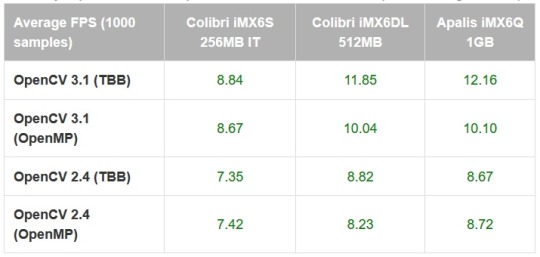
As a comparison, the Canny algorithm was replaced in the code with the Sobel derivatives, based on this example. The results are presented in table 2:
Table 2 – Sobel implementation comparison between modules and OpenCV configurations (640x480)
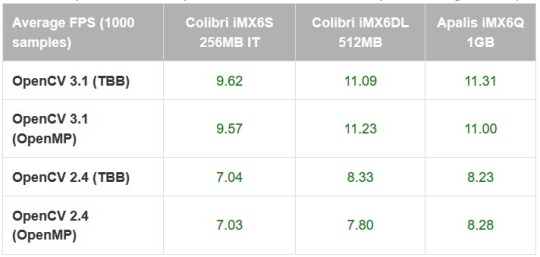
It is interesting to notice that using the TBB framework may be slightly faster than OpenMP in most of the situations, but not always. It is interesting to notice that there is a small performance difference even for the single-core results.
Also, the enhancements made from OpenCV 2.4 to OpenCV 3.1 have a significant impact in the applications performance – which might be explained by the NEON optimizations made so far, and also an incentive to try to optimize the algorithms that your application requires. Based on this preliminary results, it is interesting to test a specific application with several optimization combinations and using only the latest OpenCV version before deploying.
Testing an OpenCV face-tracking sample
There is also a face-tracking sample in the OpenCV source-code that was tested, since it is heavier than the previously made tests and might provide a better performance awareness regarding Colibri x Apalis when choosing the more appropriate hardware for your project.
The first step was to copy the application source-code from GitHub and replace the contents of myApp.cpp, or create another file and modify the CMake script if you prefer. You will also need the Haar cascades provided for face and eye recognition. You might as well clone the whole OpenCV git directory and later test other samples.
A few changes must be made in the source-code so it also works for OpenCV2.4: include the stdio.h library, modify the OpenCV included libraries (take a look in the new headers layout section here) and make some changes to the CommandLineParser, since the versions from OpenCV 2 and 3 are not compatible. Image 5 presents the application running:

Face and eye tracking application
The code already prints the time it takes to run a face detection. Table 3, presented below, holds the results for 100 samples:
Table 3 – Face detection comparison between modules and OpenCV configurations (640x480)
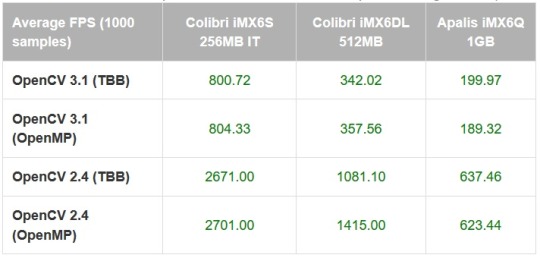
Again the difference between OpenCV versions is not negligible - for the Apalis iMX6Q (quad-core) the performance gain is 3x, and using OpenCV 3.1 with the dual-core Colibri iMX6DL delivers a better performance than OpenCV 2.4 with the quad-core Apalis iMX6Q.
The single-core IT version, thus with reduced clock compared to the others, has results far behind as expected. The reduced clock may explain why the performance improvement from single to dual core is higher than dual to quad core.
Conclusion
Since OpenCV is nowadays (probably) the most popular set of libraries for computer vision, and with the enhancement of performance in embedded systems, knowing how to start with OpenCV for embedded applications provides a powerful tool to solve problems of nowadays and the near future.
This blog post has chosen a widely known family of microprocessors as an example and a starting point, be for those only studying computer vision or those already focusing on developing real-world applications. It also has demonstrated that things are only starting – see for instance the performance improvements from OpenCV 2 to 3 for ARM processors – which also points towards the need to understand the system architecture and focus on optimizing the application as much as possible – even under the hood. I hope this blog post was useful and see you next time!
Summary
1) Building image with OpenCV To build an image with OpenCV 3.1, first follow this article steps to setup OpenEmbedded for the Toradex image V2.7. Edit the OpenCV recipe from meta-openembedded, adding the following line:
CXXFLAGS += " -Wa,-mimplicit-it=thumb"
In the local.conf file uncomment your machine, accept the Freescale license and add OpenCV:
MACHINE ?= "apalis-imx6" # or colibri-imx6 depending on the CoM you have ACCEPT_FSL_EULA = "1" IMAGE_INSTALL_append = " opencv"
2) Generating SDK Then you are able to run the build, and also generate the SDK:
bitbake –k angstrom-lxde-image bitbake –c populate_sdk angstrom-lxde-image
To deploy the image to the embedded system, you may follow this article's steps.
3) Preparing for cross-compilation After you install the SDK, there will be a sysroot for the target (ARM) inside the SDK directory. Create an OpenCV directory inside <path_to_ARM_sysroot>/usr/lib/cmake and, inside this new directory create a file named OpenCVConfig.cmake with the contents presented below:
cd /usr/lib/cmake mkdir OpenCV vim OpenCVConfig.cmake --------------------------------------------------------------------------- set(OPENCV_FOUND TRUE) get_filename_component(_opencv_rootdir ${CMAKE_CURRENT_LIST_DIR}/../../../ ABSOLUTE) set(OPENCV_VERSION_MAJOR 3) set(OPENCV_VERSION_MINOR 1) set(OPENCV_VERSION 3.1) set(OPENCV_VERSION_STRING "3.1") set(OPENCV_INCLUDE_DIR ${_opencv_rootdir}/include) set(OPENCV_LIBRARY_DIR ${_opencv_rootdir}/lib) set(OPENCV_LIBRARY -L${OPENCV_LIBRARY_DIR} -lopencv_aruco -lopencv_bgsegm -lopencv_bioinspired -lopencv_calib3d -lopencv_ccalib -lopencv_core -lopencv_datasets -lopencv_dnn -lopencv_dpm -lopencv_face -lopencv_features2d -lopencv_flann -lopencv_fuzzy -lopencv_highgui -lopencv_imgcodecs -lopencv_imgproc -lopencv_line_descriptor -lopencv_ml -lopencv_objdetect -lopencv_optflow -lopencv_photo -lopencv_plot -lopencv_reg -lopencv_rgbd -lopencv_saliency -lopencv_shape -lopencv_stereo -lopencv_stitching -lopencv_structured_light -lopencv_superres -lopencv_surface_matching -lopencv_text -lopencv_tracking -lopencv_videoio -lopencv_video -lopencv_videostab -lopencv_xfeatures2d -lopencv_ximgproc -lopencv_xobjdetect -lopencv_xphoto) if(OPENCV_FOUND) set( OPENCV_LIBRARIES ${OPENCV_LIBRARY} ) set( OPENCV_INCLUDE_DIRS ${OPENCV_INCLUDE_DIR} ) endif() mark_as_advanced(OPENCV_INCLUDE_DIRS OPENCV_LIBRARIES)
Inside your project folder, create a CMake script to generate the Makefiles for cross-compilation, with the following contents:
cd vim CMakeLists.txt -------------------------------------------------------------------------------- cmake_minimum_required(VERSION 2.8) project( MyProject ) set(CMAKE_RUNTIME_OUTPUT_DIRECTORY "${CMAKE_BINARY_DIR}/bin") add_executable( myApp src/myApp.cpp ) SET(CMAKE_PREFIX_PATH /usr/local/oecore-x86_64/sysroots/armv7at2hf-neon-angstrom-linux-gnueabi) SET(OpenCV_DIR ${CMAKE_PREFIX_PATH}/usr/lib/cmake/OpenCV) find_package( OpenCV REQUIRED ) include_directories( ${OPENCV_INCLUDE_DIRS} ) target_link_libraries( myApp ${OPENCV_LIBRARIES} )
Export the SDK environment variables and after that run the CMake script. In order to do so, you may run:
source /usr/local/oecore-x86_64/environment-setup-armv7at2hf-neon-angstrom-linux-gnueabi cmake .
4) Cross-compiling and deploying Now you may create a src directory and a file named myApp.cpp inside it, where you can write a hello world application, such as this one:
mkdir src vim src/myApp.cpp -------------------------------------------------------------------------------- #include #include <opencv2/opencv.hpp> using namespace std; using namespace cv; int main(int argc, char** argv ){ Mat image; image = imread( "/home/root/myimage.jpg", 1 ); if ( !image.data ){ cout << "No image data \n"; return -1; } namedWindow("Display Image", WINDOW_AUTOSIZE ); imshow("Display Image", image); waitKey(0); return 0; }
Cross-compile and deploy to the target:
make scp bin/myApp root@<board-ip>:/home/root # Also copy some image to test! scp <path-to-image>/myimage.jpg root@<board-ip>:/home/root
In the embedded system:
root@colibri-imx6:~# ./myApp
0 notes
Text
Game Dev Update | 1.30.17

“Aaaaaaaiiiiiiiii am coming for you!!!”
Raowr. The game is taking greater shape each day, and I have much to share-- we’re sprinting toward a big show (explained below), a big milestone (PVE is close to online for realzies) and a big round of testing that we’ve teased you with for far too long.
Last time, we covered Legendary Helms, Mages, Narrative, Abilities and the Map (plus moar). This time, well-- we’re gonna get deeper on the visual tests we’re doing to give players more information about their opponent, we’re going to examine the state (and features) of PVE play, we’ll examine some of the choices players will have in the narrative, and we’re diving in deeper to specific Abilities (read: moves) to explain what they do.
Let us ride on our enemies:
EXILES AT GDC WITH EPIC
We’re very excited to share that Exiles is going to be a showcase title in Epic’s booth at the Game Developer’s Conference in San Francisco, March 1-3. We just submitted the artwork for our area in the booth, so a setup that looks like this (below) will see the Gunslinger team hosting head-to-head bouts of Exiles for all comers:

If you’re going to be at GDC and want to set time for us to look out for you, hit us with a comment here or PM TheWizard on the forums, and we’ll figure out how to do a very special demo for you and an opponent (or play one of us!).
RARE TELLS
There’s been a decent amount of discussion about this topic on the Exiles Discord channel, so let’s talk about the system that we’re experimenting with to give players some visual telegraphs about their (live) opponents’ build. Besides aesthetics, we’re testing this to see if having an idea of an opposing player’s build changes/alters/improves the player’s ability to make choices of what Ability to play against their foe.
As you can see here, we’ve organized the 150 or so “prefixes” on loot into 8 categories (note: a prefix is a word that denotes effects like Flaming, Unstoppable or Nimble prior to the base name of the equipment like Robes or Shoulders).

From a combat standpoint, the intension is to provide a telegraph to skilled players about how their opponent is specced out. We’ll be testing this hypothesis during closed beta and beyond, but jump into the discussion prior to that here on the forums.

PVE COMING ONLINE
Yes, I’ve been threatening this for a while, but now it’s becoming a reality. PVE is moving from the prototype level to the system level! We shared the way the world map works (video here), and now the system for Quests, Narrative Choices (think Choose Your Own Adventure) and random treasure is nearing implementation. A player’s adventures through Embermark will open up activities to engage in that move their own development forward as well as the overall world’s. Using this image to illustrate, the system will allow the following:
Quests that unlock based on previous Quest completion, Class, and Event participation (accessed from those mountain, door and tower buttons you see on the screenshot)
Access to individual areas (read: maps of specific locations) for further adventures
Hidden active areas on the screen that, when clicked, access any of the above
Presentation of narrative choices that will affect both your Motivations as a player and the overall storyline of the game (see the next section of this Update for explanation)
Access to random (or authored) TRAYSURE

NARRATIVE CHOICES
A week or two ago, we shared that our partnership with Bound is off and running with the delivery of the first several Exiles story beats to be revealed before the game comes out. That should be interesting, as the narrative content in Bound will morph from a narrator telling players what’s what on the continent of Embermark to him reporting on what happened last Season when the game is actually underway.
As that is happening, we’re developing all the ways that players will make choices that affect both their experience and the overall direction of the world story.
One of these ways is simple narrative choices. Along the player journey, they will encounter areas on the map that ask them a simple question. The question might be whether or not to help a NPC, which angle to take in an argument or what preference they have of one Quest line over another. Each choice by each player will affect both their individual Motivation profile (accessed in their Character Detail) and the overall “vote” of the player base for that choice, which will affect the way each Season’s story is told (a Season is a month or so in the game).

And Exiles wouldn’t be much of an RPG if there weren’t tons of secrets and treasure to earn or find, right? Periodically throughout a Character’s development, treasure will appear on the map. Sometimes it will be a random drop, sometimes it will be a Recipe to craft something awesome and sometimes it will be a Legendary that you simply must have (and no, this one is not called “Forest Legendary.” We do have some pride, people...

ANOTHER MUSIC BIT
It’s been a few updates since our first Exiles soundtrack preview, so it’s high time for another! If you’ve been following the game’s development for a while, you know that at around Level 10, players will be able to join a House that fits with their ideology as a Character. During that decision process, you’ll be listening to this track, and then after making your decision, there will be a unique House theme playing as you make your decisions in the various sections of the House experience. Have a listen to the main House theme, and then vote on which House’s unique music theme we showcase next (vote here).
WARRIOR ANIMS
This Ogre’s gonna lose his knees when you unleash BEDLAM on his ass.

ITEM DETAILS
UI design & iteration continues fast and furious, and the challenges of designing for a profile view (versus a landscape view) when there’s stats to share are something we’ll want tons of feedback on as we test.
Here, you can see the “comparison view” for what you’re currently equipped with (the Shining Helm of Lasting) and what you’re considering (Durashan’s Wind of Wrath). In typical RPG convention, green denotes an improvement over what’s currently equipped and red shows what’s inferior to current.

THE WOLF REVEALED
As we move from sketch to fully realized character, the lore behind wolves in Embermark is becoming clear. Their level of intelligence was heightened during the Collapse and their level of organization came shortly after. How?
Not tellin’. But you should play the game, really. I hope you’ll be pleased, though these enemies won’t be pleasing. Particularly this guy:

1ST ABILITY DEEP DIVE
It occurred to me that all this talk of “Abilities” and explaining them as moves doesn’t fully explain the types of decisions that players will need to make in combat. So to illustrate a little more explicitly, I’m going to start breaking down some of the Abilities in the game so you can get an idea of what they do as well as what they might synergize with.
This time around, we’ll focus on a couple of Warrior Abilities:

Defiant Shout: Removes all active debuffs currently on you and increases WIL.(for reference, WIL increases all resistances, reduces Fire and Curse damage and increases damage on Abilities with a cooldown of 2 or more rounds).
This is a big Ability for the Warrior who wants to last. Rounds in Exiles are quick and you only have a few seconds to make your decisions. If you get loaded up on debuffs from a wily Mage or backstabbing Rogue, you could be in trouble before you can start unleashing your big damage attacks. Defiant Shout often saves the Character from an early demise but also sets up Abilities like Bedlam (which does multiple strikes and a bazillion damage if hitting) for finishing off the enemy.

Lunge: Deals damage and includes a chance at destroying armor but can't be used unless your SPD is less than the target’s. (for reference, SPD is super important in the Initiative calculation and also increases awareness and mitigates Lightning-type damage).
This is a great follow-up Ability, given it’s a gamble on the first round of combat (you won’t know if your SPD is less than your filthy foe). If you see the opponent win Initiative, you get debuffed on SPD by the opponent, or you execute an Ability that lowers your SPD, you can follow up with Lunge and plunge the enemy’s armor rating into the toilet. Then you watch as he/she fumbles around with buffing or a panic damage Ability and you deliver something that does mad damage.
WHAT’S COMING
Moar (it’s always that).
We’ll keep sharing details as we head into testing (remember to PM TheWizard on the Exiles forums if you want in on closed testing & beta later), and you can count on early impressions from the testers throughout our various channels.
If you haven’t already, follow along with the Exiles development on Twitter, Instagram and Facebook. And if you haven’t, I’ll find you. And SMITE you.
BONUS IMAGE: WHO IS THAT?
Or is it anyone?
Given our large contingency of wizard-lovers (including myself), I don’t like to leave without a shoutout to magicks, so check out this blown-up image of our Chain Lightning icon (c’mon, we’re not making an RPG and excluding Chain Lightning, people).
In addition to the drama of the arcane lightning, there appears to be a dark head and shoulders amidst the storm. Given this image will be relatively tiny in the game (it’s an icon), don’t forget about that dark figure when you see it. And if you remember when the lore behind arcane chain lightning is revealed, remind us that this Dark Figure is there and we’ll explain why.

4 notes
·
View notes